PinotFile: 7.15 March 26, 2009
|
Rece$$ion Busting Oregon Pinot NoirOregon turned 150 on Valentine’s Day, February 14, 2009. America’s thirty-third state is celebrating its sesquicentennial and has even broke out a song, “Oregon! Oregon!”, that was originally performed for the state’s 100-year anniversary. It doesn’t quite have the ring of “New York! New York!”, but give those spirited dreamers credit for trying. The United States Postal Service has issued a commemorative stamp to mark the occasion. I think they should have put a picture of a Pinot Noir vineyard on the stamp. I love the fish and crab that come out of the coastal waters of Oregon, but it is Pinot Noir that is Oregon’s calling card today.
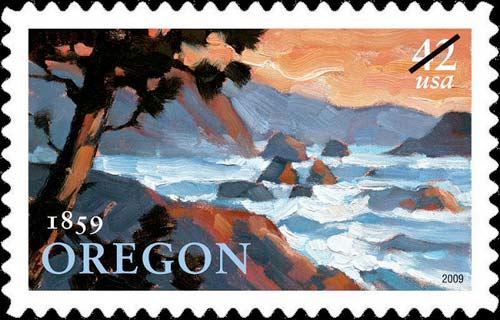 Oregon is facing serious economic challenges in step with the entire nation and a double digit unemployment rate in the state is on the horizon. The wine industry in Oregon has experienced a slowing sales growth. At the 2009 Oregon Wine Symposium in Eugene, sponsored by the Oregon Wine Board, Barbara Insel from Stonebridge Research, reported that inventory in wineries and restaurants and at distributors was increasing. Consumers are buying, but they are buying less quantities and lower priced wines. Oregon’s Bill Hatcher, a partner in A to Z Wineworks, has lately been forecasting a gloomy outlook for Oregon. Hatcher estimates that Oregon is producing twice the wine it can sell. The 2007 Oregon Vineyard and Winery Report indicates that there are 395 wineries in the state, a marked increase from 195 only a few years ago. Jim Bernau, CEO of Willamette Valley Vineyard, Oregon’s third largest winery, told Oregon Wine Press recently that, “The greatest opportunity is in our value priced wines. Movement at the higher price points has stalled.” When I inquired recently at a few busy local wine retailers in Southern California, I was told that sales had stalled for Oregon and California Pinot Noirs priced above $50 and consumers were more likely to seek out bargains. According to Cyril Penn, Editor of Wine Business Monthly, “Pinot Noir may be “hot,” but for the first time in a while, the bulk wine brokers have shelves filled with Pinot Noir samples. They even have Oregon Pinot Noir samples to share.” It is ironic that wine sales are lagging at a time when people, particularly Millennials, are becoming more interested in wine and the quality of wine produced in Oregon and California is at an all time high. I normally receive occasional inquires asking, “What’s a good Pinot for under $25?” Lately, this has been a constant question. Value has become the new bling. Finding wine values is now hip. Last year I ran a feature in the PinotFile (Volume 7, Issue 6) on Recession Busting Pinot Noirs from California priced less than $20 and summarized numerous value-priced California and Oregon Pinot Noirs tasted in 2008 in the end of year edition (Volume 7, Issue 9). I am one of the few wine reviewers who spends time sampling low-priced Pinot Noir in the marketplace, that is, the kind of wines many consumers buy on a daily basis at their local discount wine retailer, liquor and grocery store. It is a class of wines largely neglected in the wine press, yet is a highly popular category of Pinot Noir. Savvy customers are demanding decent wines at affordable prices. Some of these wines are of poor quality and tarnish Pinot Noir’s reputation but many that are sourced from California and Oregon fruit are surprisingly good as daily drinkers. My intent in reviewing inexpensive wines is to uncover sensibly priced Pinot Noirs that can be enjoyed on the back porch or with simple meals and will leave you satiated and solvent. This feature is devoted to Recession Busting Oregon Pinot Noirs priced at or less than $25. Why set a limit of $25 rather than $20 as I did for California Pinot Noirs? If I had limited the review to Oregon Pinot Noirs under $20, I would have had very few from the excellent 2006 and 2007 vintages to recommend. There is a big jump in quality for wines as you cross the $20 threshold. Remember that when you buy Oregon Pinot Noir from retailers located within Oregon, you pay no sales tax. This softens the blow of shipping charges which have noticeably increased over the past year. However, Oregon wineries are required to charge the buyer their state’s sales or use tax and in some cases even tax on product and shipping costs. To offset this, many wineries are offering discounts on 6 or 12 bottle purchases and reduced or no shipping charges on significant purchases. I have divided the 42 wines I sampled into three categories: Recession Busters (highly recommended), Recession Bumpers (worth consideration), and Recession Busts (you have been forewarned). The overall high quality of Oregon Pinot Noirs in this underbelly price category is impressive, with very few wines a bust. One important consideration in Pinot Noir under $25 is that you need to lower your expectations. These wines do not have the sensual aromatics of more expensive PInot Noirs and lack nuance and complexity on the palate. That said, they can provide a perfectly fine daily drinking experience. It all goes back to that old saw: you get what you pay for. As a side note, I found a higher number of corked wines (compared to more expensive Pinot Noirs) in sampling this price category. However, I had no difficulty returning corked wines to retailers who happily replaced the defective bottles. I think you will find that producers will do the same. Prices listed are either the retail price I paid for the wine or the retail price at the winery or both. In today’s competitive retail wine marketplace, prices can vary considerably. 2007 is the most current vintage on the marketplace, with many wines from the 2006 vintage also available, and even a few leftovers from the 2005 vintage. Generally, the under $25 Pinot Noirs are made for early drinking and are at their best consumed soon after release. Oregon Pinot Noirs from the 2006 vintage have deeper color, more alcohol (even over 15%), richer fruit (more “Caliesque”) and more tannin. The Oregon Pinot Noirs from the 2007 vintage are more classic with lighter color, less tannin and alcohol, lighter fruit (more austere), more elegance and bright acidity. The 2007 wines need food to bring them into focus; the 2006 wines can stand on their own. Buy 2006 for lust, buy 2007 for love!
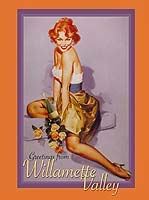
Rece$$ion BustersHighest commendation in the tasting is awarded to St. Innocent.
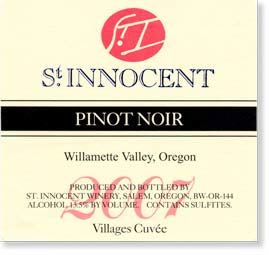 2007 St. Innocent Villages Cuvée Willamette Valley Pinot Noir 13.5% alc., 2,043 cases, $25. A blend of grapes sourced from Vitae Springs, Freedom Hill, and Zenith vineyards cropped at 1.2 to 2.7 tons per acre. Young plantings are blended with a consistent Pinot Noir base wine from both old and new blocks of the Vitae Springs Vineyard. In Oregon and through the St, Innocent tasting room, this cuvée is entirely from Vitae Springs Vineyard but the cuvée sold in other United States markets contains 80% of Vitae Springs Vineyard with some Zenith Vineyard and Freedom Hill added in. Aged 13 months in 20% new French oak. Unfined and unfiltered. Winemaker Mark Vlossak is at the top of his game. · The wine’s aromatics build in the glass and really erupt over time, always a sign of a superior wine. The nose offers scents of fresh cherries and raspberries kissed by oak and spice. Cherry driven flavors with a floral and citric accent are offered in an elegant style that is light and harmonious. The winemaking pedigree shows through in this very good wine that will hold on and drink well for another 4 or 5 years. At $252 a case, this is a perfect choice for recession slumdogs.
 2007 Annie Amie Vineyards Cuvée A Willamette Valley Pinot Noir 13.3% alc., 3,200 cases, $25. An eight vineyard blend from estate vineyards and purchased grapes including clones 115, 777, Pommard and Wädenswil. This wine is a selection of forward and charming barrels of Pinot Noir, blended in a style ready to drink upon release. Aged 10 months in 11.5% new French oak, 21.2% 1-year French oak and 67.3% neutral oak. Once bottled, the wine was aged for 8 months before release in February 2009. Palate of soils include Willakenzie, Jory and Laurelwood. Crafted by winemaker Thomas Houseman and winegrower Jason Tosch. This bottling is the winery’s entry-level Pinot Noir. · Light ruby color. Rather intense scents of cherries, herbs and cream soda. A lighter-weighted black cherry-driven wine with a complimentary hint of vanillin and spice that finishes with a touch of grapefruit. A clean and very decent wine for drinking now.
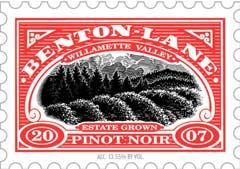 2006 Benton Lane Oregon Pinot Noir 14.1% alc., $20 (winery retail is $26), approximately 20,000 cases, screw cap. This family owned winery dates to 1988 and is located in the southern Willamette Valley in Monroe, about half way between Corvallis and Eugene. The 2007 version of this wine is in current release. · Lightly colored. Intense aromas of ripe red berries. Fresh strawberry and raspberry flavors with an underpinning of oak and spice. Supple tannins make for easy drinking. Everything you could ask for in a $20 Pinot Noir.
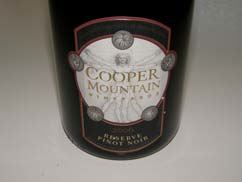 2007 Cooper Mountain Vineyards 20th Anniversary Reserve Willamette Valley Pinot Noir 13.0% alc., $19 (winery retail is $24). Estate bottled. A blend from certified organic and biodynamic vineyards. · A trilogy on the nose of black cherries, raspberries and black currants. Juicy core of black raspberry fruit, subtlety spiced with fine-grained tannins anchoring the nicely structured backbone and a touch of refreshing citrus-laden acidity bringing up the finish. This wine is a steal at this price.
2006 Crowley Entre Nous Willamette Valley Pinot Noir 14.4% alc., 150 cases, $27 (available from Storyteller Wine Company (www.storytellerwine.com) for $24 a six pack). Proprietor and winemaker Tyson Crowley is a New York transplant who spent 12 years learning his trade at Erath Vineyards, Cameron Winery, J.K. Carriere, Archery Summit and Brick House. 75% Dundee Hills fruit from La Colina Vineyard (Wädenswil) and 25% Ribbon Ridge fruit (Pommard). Aged 18 months in 50% new French oak. Second vintage of Pinot Noir for this producer. · Prominent scent of black raspberries with a nice touch of smoky oak. Dark fruited and full-bodied with a hint of dark chocolate and charcoal. The darker side of Pinot Noir, almost Syrah-like, but never crosses the line. Wellcrafted and typical of many Pinot Noirs from the 2006 vintage in Oregon. You can almost make a meal out of this one.
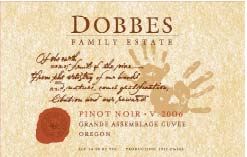 2006 Dobbes Family Estate Grand Assemblage Cuvée Willamette Valley Pinot Noir 13.5% alc., 2,937 cases, $25. A 9 vineyard blend with each vineyard cropped at approximately 2 tons per acre. 70% whole berry fermentation, 6 day cold soak, racked once before blending and aged 10 months. · Moderate light in color. Very alluring nose of strawberries, blueberries, slightly confected cherries, baking spice and graham. A playful wine that is medium-bodied and features refreshing flavors of strawberries, raspberries and cherries with the slightest hint of herbs. Supple tannins, adequate acidity and an elegant disposition. A wine for foodies.
 2007 Elk Cove Vineyards Willamette Valley Pinot Noir 13.5% alc., 19,750 cases, $21. Family owned and managed winery with 600 acres on four vineyard sites. The focus is the Pinot Trilogy: Noir, Gris and Blanc. This wine is composed of Pommard and Dijon clones. · Complex aromatic profile featuring dark berry fruits, aged wood, fresh-mown grass and a hint of chocolate. The flavors echo the aromas with some added earthiness and woodsy fungi notes. Unusually hearty richness and color for a 2007 vintage Oregon Pinot Noir. Barely noticeable tannins and a dry finish. Well-crafted and easy to drink.
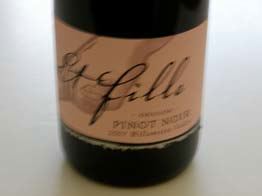 2007 Et Fille Willamette Valley Pinot Noir 12.9% alc., 153 cases, $24. A blend of Pinot Noir grapes from Blakeslee, Shaw Mountain, Kalita and Palmer Creek Vineyards. Aged 9 months in 33% new French oak barrels. · Cherries, strawberries, roasted nuts and oak char on the nose. Tasty fruit flavors of red cherries, cranberries and strawberries with a little mocha in the background. Tannins are nicely managed and the whole package is very clean and refreshing. A dependable Pinot for mealtimes.
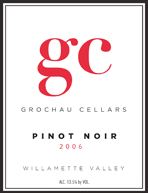 2007 Grouchau Cellars (GC Wines) Willamette Valley Pinot Noir 13.5% alc., 1,350 cases, $24. A relative newcomer in Oregon founded in 2002 by John Grochau and his wife Kerri. John is a sommelier (13 years at Higgins in Portland) who learned his winemaking at Brick House and Erath Winery. This wine is a blend of 4 vineyards. · Darker fruited nose enhanced by scents of violets, grapes and buttered toast. Blackberries are most prominent on the palate. The wine has a very sensual velvety texture, minimal tannins and a lively acid backbone making it easily approachable and satisfying. I have found that sommeliers have a special winemaking touch, particularly with Pinot Noir.
2007 H Willamette Valley Pinot Noir 13.5%, $21, screw cap. Second label from Hamacher Wines (Carlton Winemaker’s Studio). Any wine in barrel after 18 months that does not elevate the quality of the Hamacher blend is “declassified” into H and sold just after bottling. The sole purpose of “H” is to make the Hamacher Pinot Noir look better, but you won’t be disappointed with “H” in comparison to other Pinot Noirs at this price point. · Shy initially but builds in interest in the glass. Red cherries, wildflowers, herbs and hay on the nose. Middle weighted cherry and berry flavors with a vein of herbs running through. Admirable richness with fine-grain tannins and respectable harmony.
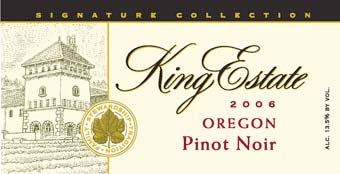 2007 King Estate Signature Oregon Pinot Noir 13.0% alc., $23 (winery retail is $29). King Estate is home to the largest contiguous organic vineyard with over 465 acres planted. Director of Viticulture and Winemaking is John Albin. All vineyards are dry-farmed. Aged 10-12 months in French oak barrels, 27% new, medium toasted staves. · High-spirited scents of red raspberries and spiced cherries. Modest but satisfying cherry and berry core augmented with subtle oak accents and displaying gossamer tannins and a hint of citrus peel on the finish. Lacks some punch on the mid palate but will work perfectly fine at the dinner table.
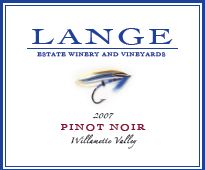 2007 Lange Estate Winery & Vineyards Willamette Valley Pinot Noir 13.2% alc., 5,500 cases, $24. Don and Jesse Lange craft stellar Pinot Noirs from estate vineyards in the Dundee Hills. This wine is an assemblage of all the Lange Estate North Willamette Valley vineyard sites. Aged 9 months in 10% new French oak. · A redder profiled wine typical of Dundee Hills. Pleasing accents of oak, herbs and orange peel. Smooth textured with mild tannins and a refreshingly brisk finish. No rough edges. The Reserve bottling priced at $32 is also a superb wine with more fruit intensity and tannin and is built for more years in the cellar.
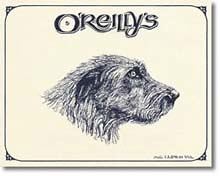 2007 O’Reilly’s Oregon Pinot Noir 13.0% alc., $17. This wine is consistently one of Oregon’s top value-priced Pinot Noirs and this vintage is no exception. David O’Reilly (Owen Roe) has crafted this wine for over ten years. The Irish wolfhound on the label was a pub dog at an Irish restaurant and bar that O’Reilly’s cousin owns in San Francisco. Aged in 3 to 4 year-old oak barrels. · Lighter and more feminine than is typical for this Pinot Noir but reflecting the 2007 vintage. Flavors and aromas of red cherries and cranberries augmented with minerality, spice and orange peel. Needs some time in the glass to blossom. Reminds me of the more austere Eyrie Vineyards style.
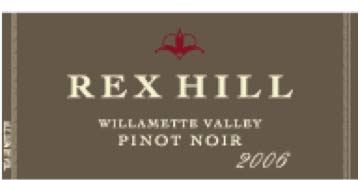 2007 Rex Hill Willamette Valley Pinot Noir 13.5% alc., $20. Rex Hill is named after the steep slope at the northern entry to the Willamette Valley. The winery is owned by a partnership consisting of Bill and Debra Hatcher, Sam Tannahill and Cheryl Francis who are also partners in A to Z Winewworks in Oregon. Aged in French oak barrels for 9-10 months. · A dark fruit hued wine that is rich and full-bodied. Black cherries, blackberries and plums are accented by tea and toast flavors wrapped around substantial tannins. These bold wine is atypical for the 2007 vintage in Oregon but it will find plenty of fans.
 2007 Owen Roe Sharecropper’s Oregon Pinot Noir This is a very popular Pinot Noir sourced from several Willamette Valley vineyards. Like the O’Reilly’s, crafted by David O’Reilly. · Unique and pleasurable aromas of strawberry tart, brioche, sandalwood and vanilla wafers. Primarily strawberry flavors with a hint of root beer. Nicely balanced with soft tannins and a dry, clean finish. I like this wine because the acid doesn’t overpower as it does in many Oregon 2007 Pinot Noirs. One of the best 2007 under $25 Pinot Noirs I tasted.
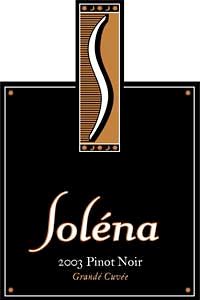 2006 Soléna Grande Cuvée Willamette Valley Pinot Noir 14.5% alc., 3,500 cases, $22 (winery retail is $25), Vacu-Seal (glass). Crafted by Laurent Montalieu and Danielle Andrus Montalieu from vineyard sites throughout the Willamette Valley including the Estate vineyard Domaine Danielle Laurent. Grapes were fermented in small lots with total of 20 days of skin contact. Aged 6 months in 17% new French oak barrels. · Unfined and unfiltered. Shy but pleasant scents of red and even tropical fruits. Satisfying core of red berry and red plum fruit with some underlying earthiness. Nicely composed and harmonious with fine-grained tannins.
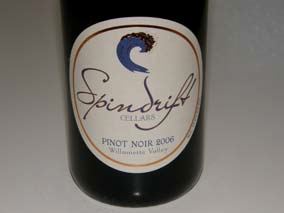 2006 Spindrift Cellars Willamette Valley Pinot Noir 14.2% alc., $25, screw cap. This winery is located in Philomath, Oregon, 5 miles west of Corvallis. The few wineries in this area are not as visible as those from the northern Willamette Valley but the wines are equally fine. Aged 10 months in French oak barrels. · Unfiltered. Perfect marriage of crushed berries, herb garden, flowers and barnyard on the nose. Tart berries, including cranberries, on the palate with a touch of oak. Decent richness, smoothly textured and a pleasing citrus lift on the persistent finish. Plenty to like here.
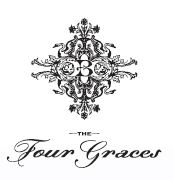 2007 The Four Graces Willamette Valley Pinot Noir 13.5% alc., $18.50 (winery retail is $29). A popular choice in restaurants and a wine I recently drank at Wild Fish Restaurant in Newport Beach, California. From the owners of Black Family Vineyard in the Dundee Hills AVA. Pommard and Dijon clones. Sustainable farming and yields of no more than 2 tons per acre. · Deeply colored for a 2007 vintage Pinot Noir. Black cherry is the driving force in this wine on the nose and among the flavors with some accents of roses, oak toast and spice. A cozy wine with a respectable tannic structure and a dry finish.
 2007 Witness Tree Vineyards Willamette Valley Pinot Noir 13.6% alc., $25 (winery retail is $28). From the Witness Tree 100-acre estate in the Eola Hills. · Nicely perfumed with black cherries, spiced plums, herbs and new oak. Easy to cozy up to with tasty dark stone fruits, vanillin, Moroccan spice and char with a lively finish. A well-crafted daily drinker.
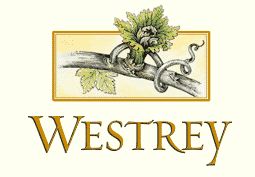 2007 Westrey Willamette Valley Pinot Noir 13.5% alc., $22. Amy Wesselman and David Autrey craft small lots of Pinot Noir from purchased grapes and their estate Oracle Vineyard in the Dundee Hills. Their wines tend to be lighter and more restrained, are built for aging and are very sensibly priced. · Shy but pleasant aromas of red fruits and Provencal herbs. The red fruit theme carries over in the delicate flavors which include a judicious touch of spice. Juicy and crisp with supple tannins.
Rece$$ion Bumpers
 13.5% alc., $15, screw cap. “Aristocratic wines at democratic prices.” · Aromas of ripe red berries which are slightly confected and herb-kissed. Crisp and juicy with reserved tannins and a lively touch of citrus zest on the finish.
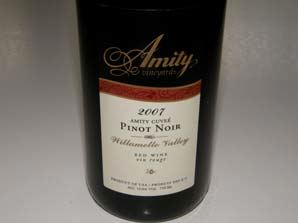 2007 Amity Vineyards Amity Cuvée Willamette Valley Pinot Noir 13%, $20. From 6 dry-farmed vineyards in the northern Willamette Valley including clones Dijon 115, Wädenswil, Pommard and Upright. Myron Redford and Darcy Pendergrass are the winemakers. · On the nose there are strawberries, cherries, juicy fruit gum and a touch of cardamon spice. Light-weighted and nicely spiced red fruits with some cedar and grapefruit zest flavors, soft tannins and zingy acidity.
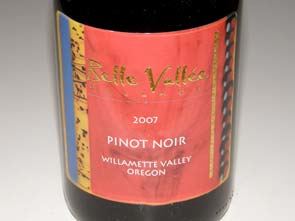 2007 Belle Valle Cellars Willamette Valley Pinot Noir 13.6% alc., $24. · Light ruby color. Prominent oak char and dark caramel on the nose. Oak and toastinfused black cherry fruit which is light and juicy. No tannins to speak of and adequate acidity. This wine will appeal to those who like oak with their Pinot.
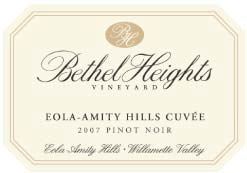 2007 Bethel Heights Vineyard Eola-Amity Hills Cuvée Willamette Valley Pinot Noir 13.6% alc., $23 (winery retail is $30). · Moderately light reddish-purple color. Shy aromas of cherries and wine cave. Red fruited with bright acidity and a touch of citrus on the zesty finish. A simple but satisfying drink that is nicely crafted.
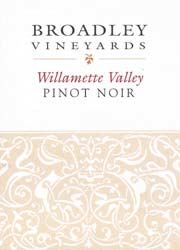 2007 Broadley Vineyards Willamette Valley Pinot Noir 13.5% alc., $20 A blend of several vineyards from a consistently well-regarded family owned winery producing 5,000 cases of Pinot Noir annually. Located in Monroe, Oregon, about half way between Corvallis and Eugene. · A middle weighted Pinot Noir offering slightly roasted and sweet dark berry fruits accented by clove, oak, maple syrup and balsam. Lively acidity on the refreshing and dry finish.
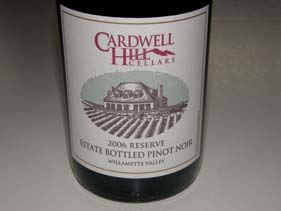 2006 Cardwell Hill Cellars Reserve Willamette Valley Pinot Noir 13.2% alc., 500+ cases, $26. From plantings of Dijon, Pommard and Wädenswil clones in Philomath, Oregon. The best 21 barrels in the cellar. Aged 18 months in French oak barrels. Unfined and unfiltered. · Very ripe dark fruits are featured with hints of raisin and port, stopping short of prune. Deft touch of cardamon and clove spice. Very smooth mouthfeel. Well-crafted but the fruit is a little riper than I prefer.
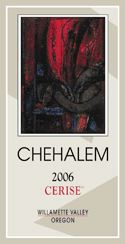 2006 Chehalem Cerise Willamette Valley Pinot Noir 14.5% alc., 391 cases, $24. 80% Gamay Noir, 20% Pinot Noir. “Cerise” is cherry in French. This wine is analogous to passetoutgrains in Burgundy which is made for drinking while the highly structured Pinot Noirs develop. Cerise has been produced since 1992. There are two acres of Gamay Noir planted at Ridgecrest Vineyard, a 55-acre planting on a 176-acre property which pioneered grape growing on Ribbon Ridge in 1980. Aged 9 months in barrel, racked twice, sterile filtered. · The nose is restrained, showing blue and black berries, oak and some good barnyard. The wine offers black grape flavors with respectable richness and body. Anise and pepper notes add interest and the dry finish has a spirited grip of citrus zest. A good change up from the sea of Pinot Noir.
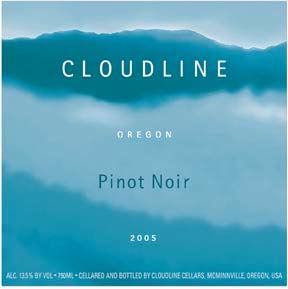 2007 Cloudline Oregon Pinot Noir 13.5% alc., $16.50. A project of Dreyfys, Ashby & Co located in McMinnville, Oregon. The consulting winemaker is Véronique Drouhin-Boss of Domaine Drouhin. · Aromas of spiced fruit compote, especially cherry, with a hint of oak and acetyl. Red fruit driven, soft and silky with supple tannins and a dry finish.
 13.0% alc., $19, screw cap. A blend of different vineyard sites in Oregon. 95% micro-oxygenation, 5% French oak barrels. · Moderately light red color. Scents of cherries, oak and green herb garden carry over to the flavors which are crisp, fresh and tart. Fairly austere and light with no detectable tannin.
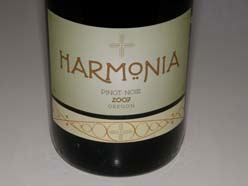 2007 Harmonia Willamette Valley Pinot Noir 13.5% alc., $22.50. Michael Beckley, the winemaker, says on his label, “In wine as in music, I believe there is a sweet spot. A point of balance and finesse that is reached when passion and skill, knowledge and dedication are applied in equal amounts.” · Restrained aromas of crushed winter berries and good barnyard. Simple and light black cherry flavors with an appealing smooth texture and modest t n’ a.
 2007 Jezebel Oregon Pinot Noir 13.0% alc., 4,674 cases, $20, screw cap. This second label of Daedalus is named after a biblical whore. This wine is a blend of several vineyards and is crafted by winemaker Aron Hess. Fermented in 60% stainless steel, 5% new and 35% neutral French oak. · Lightly colored with very demure Pinot fruit flavors. Oak char and herbs are to the front. Light and silky.
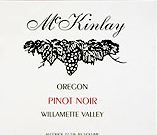 2007 McKinlay Willamette Valley Pinot Noir 12.5% alc., $18. Crafted by Matt Kinne, a respected winemaker trained at Hanzell in California before returning to his family's farming roots in Oregon. · Shy floral aromas with added darker fruits and a bit of funk. A middleweight with some richness on the mid palate core of berry and cherry flavors. An elegant wine with a grippy finish featuring a lemony zest.
2007 OFV Estate Grown Willamette Valley Pinot Noir 13.0% alc., $20, screw cap. From Olsen Family Vineyards who farm about 450 acres in five distinct vineyards in the hills between Monmouth and Corvallis, Oregon. The family has farmed in the Willamette Valley for five generations. · Very shy and nondescript aromas with a hint of cherry and camphor. More pleasing in the mouth with hearty and deep wild berry flavors with a sidecar of dark chocolate. The tannins are reigned in and the wine drinks easy.
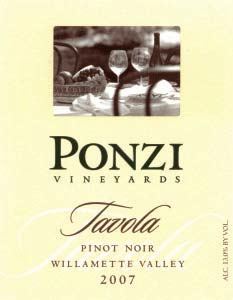 2007 Ponzi Vineyards Tavola Willamette Valley Pinot Noir 13.2% alc., 5,104 cases, $25. A blend of sixvineyards and consisting of all LIVE Certified Sustainable fruit. After an extended cold soak, fermentation continued was driven by native yeasts. Aged in 25% new French oak for 11 months. Following a barrel selection, the wine was racked and bottled by gravity without fining or filtration. · A mid-weight wine with nicely spiced red cherry aromas carrying over to the flavors. Silky textured with fine tannins and a refreshing finish with lively acidity.
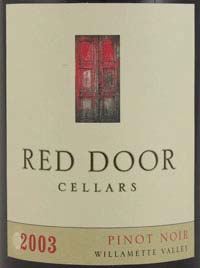 2007 Red Door Cellars Willamette Valley Pinot Noir 13.5% alc., $21 (I have seen it on the internet for $18 which is a steal). Crafted by Laurent Montalieu for NW Wine Co. (Precept Brands) in McMinnville. · Herb-dusted red fruits, sage, bay, oak and char on the pleasing nose. Very light, even ephemeral, with red cherry and strawberry flavors touched by herbs. The fruit is well-supported by supple tannins. Goes down like mother’s milk. My only nit is that the finish ends in a flash.
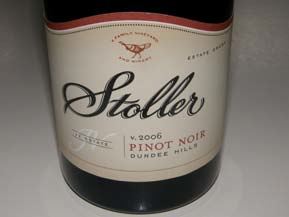 2006 Stoller JV Estate Dundee Hills Willamette Valley Pinot Noir 14.5% alc., $22. Estate grown grapes from younger hi-density vines. · Nicely spiced cherry fruit forms the basis of this medium body wine which is accented by flavors of toasted brioche and oak. Good balance of t n ‘a. The oak peeks out more as the wine warms in the glass.
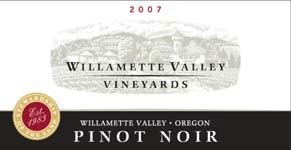 2007 Willamette Valley Vineyards Willamette Valley Pinot Noir 13.0% alc., $25. Composed of Dijon 113, 114, 115, 667, 777, Pommard and Wädenswil. Jory and Laurelwood soils. Aged in 20% new Allier forest French oak. · Mixed dark red berries and dried cherries supported by oak and grassy herbs with a little bent of forest floor. Very appealing silkiness in the mouth with gossamer tannins. Shows the herbal side of Pinot Noir
Rece$$ion BustsOf the 42 Oregon Pinot Noirs priced at $25 or less, I only found five that I don’t believe will lift your spirits in this recession.
2006 Belle Pente Yamhill-Carlton District Willamette Valley Pinot Noir 13.6% alc., $23. This has been a consistently fine producer of Pinot Noir and this may have been an off bottle. I did not have a second bottle to sample. · Primarily oak and cigar box on the nose with a hint of ripe berries. In the mouth there are flavors of black cherries with a heavy dose of smoke and oak. The tannins are soft and the texture is silky. Just too much oak for its own good.
2005 Cherry Hill Winery Papillon Estate Willamette Valley Pinot Noir 13.1% alc., $15. From a 90-acre vineyard planted to Pommard and Dijon clones. · Lighter colored. Shy aromas of grass, mint and oak. Grassy red fruits on the attack with notable tannins on the finish that overwhelm.
2006 Phelps Creek Vineyards Becky’s Cuvee Columbia Gorge Pinot Noir 13.3% alc., $20. A blend of Columbia View, Jewitt Creek, Wy’east and Phelps Creek Estate vineyards. · Aromas of grapes, red berries, flowers, chalk and cola. The fruit is very delicate and flat and carries a vegetal note. Flamboyant tannins and sharp acidity.
2007 Kings Ridge Oregon Pinot Noir 13.5% alc., $15. · Light reddish-purple color. Unusual aromatic profile of herbs, green underbrush, mustard and a touch of fecundity. In the mouth there is restrained red cherries and strawberries with a vein of savory herbs running through. Light and clean with a short finish. Tastes much better than it smells.
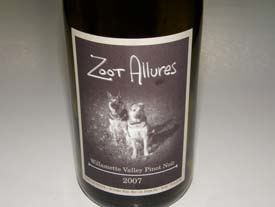 2007 Zoot Allures Willamette Valley Pinot Noir 13% alc., $19. Second label from J. Christopher Wines in Linn, Oregon that is very popular. · Shy brambly red fruits with Mediterranean spice on the nose with some alcohol peeking out. This wine is light in weight displaying decent earth-dusted cherry, cranberry and rhubarb flavors but there is some green notes that would suggest under ripe fruit. The acidity is fine and the tannins are held in check. Great label.
Et Fille 2007The 2007 vintage represents the fifth for Howard and daughter Jessica Mozeico of Et Fille Wines. The pair source grapes from the best vineyards they can find and produce small lots of Willamette Valley appellation and vineyard-designated Pinot Noirs (and a Rosé and Viognier). The wines are crafted in the winemaker’s cooperative at August Cellars in Newberg, Oregon. I have been a fan of these wines which always show an elegant and refined touch. Like many Pinot Noirs from the 2007 vintage, these wines are more austere in fruit with higher acidities and lower alcohols. They are sold through a mailing list and on the website at www.etfillewines.com. Tasting is available by appointment (503-853-5836).
2007 Et Fille Wines Willamette Valley Pinot Noir 12.9% alc., 153 cases, $24. A blend of Pinot Noir grapes from Blakeslee, Shaw Mountain, Kalita and Palmer Creek Vineyards. Aged 9 months in 33% new French oak barrels. · Cherries, strawberries, roasted nuts and oak char on the nose. Tasty fruit flavors of red cherries, cranberries and strawberries with a little mocha in the background. Tannins are nicely managed and the whole package is very clean and refreshing. A dependable Pinot for mealtimes.
2007 Et Fille Wines Palmer Creek Vineyard Eola-Amity Hills Willamette Valley Pinot Noir 13.2% alc., 73 cases, $34. Clone 777. Vineyard farmed by owners Janet and Larry Richards. Aged 8 months in 44% new French oak. · Demure aromas of cherries, herbs and oak with some heat peeking out. Slightly green red fruit flavors with noticeable tannins dominating the fruit. Light and soft with a dry finish.
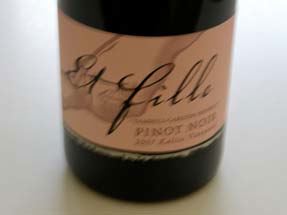 2007 Et Fille Wines Kalita Vineyard Yamhill-Carlton District Willamette Valley Pinot Noir 12.7% alc., 380 cases, $38. Vineyard is owned by Arthur and Sherry Kalita. Pommard and Wädenswil clones. Aged 9 months in 49% new French oak. · The most perfumed of the 2007 lineup showing scents of dark red cherries and red plums, red roses and a hint of oak. Delicious dark cherry bombast with accents of spice, brioche, pepper and toast. The tannins are gossamer and the cherry aromas linger endlessly on the teasing finish. This beauty has a gentle richness that is very sensual.
 2007 Et Fille Wines Maresh Vineyard Dundee Hills Willamette Valley Pinot Noir 12.9% alc., 151 cases, $42. This heritage vineyard was planted by Jim Maresh in the Dundee Hills more than thirty years ago. Pommard clone. Aged 9 months in 39% new French oak. · Decanted before tasting. Lovely deep cherry aromas show great purity. A touch of alcohol peeks out on the nose. Modest in power but delivering plenty of juicy red cherries and berries that are nicely complimented by Asian spices. Very smooth and elegant, building in intensity with time in the glass. This wine may ultimately top the Kalita. If you drink it now, spend some time with it.
Daedalus CellarsThe name Daedalus ((DAY-de-lus) is borrowed from Greek mythology and James Joyce. According to myth, Daedalus was an inventor of the Labyrinth at Knossos, a stylized version of which is represented in the winery’s logo. He was later imprisoned in his Labyrinth along with his son Icarus. They escaped, but only Daedalus made it to freedom. Stephen Dedalus appeared as James Joyce’s alter ego in A Portrait of the Artist as a Young Man and like Daedalus in the myth, represented the freedom that can be gained in creative pursuit and the costly consequences if humility is cast aside. The origins of this family owned winery read like a fairy tale. Aron Hess followed his interest in wine to the wine regions of France in 1996. One afternoon, Pam Walden was assisting a friend at an inn in the Dordogne where Aron stopped looking for lunch. The two were smitten by love and subsequently traveled together to Paris, Bordeaux and Burgundy. Aron was sent back to the United States after an encounter with a young steer in Pamplona and Pam followed him. Together they followed their dream of making Pinot Noir by packing everything they owned into the back of their car and heading for Oregon in 1997. Aron worked at Flynn Vineyards and Evesham Wood Winery before joining Rex Hill Vineyards in 1998 as an assistant winemaker working with Lynn Penner-Ash before becoming the winemaker there for three vintages (2002 to 2004). In 2000, Aron and Pam produced four barrels of Pinot Noir from Phelps Creek Vineyard in the Hood River region and Daedalus Cellars was born. In 2005 production was moved to 12th & Maple Wine Company, a custom crush facility in Dundee Oregon, where Aron is the head winemaker and crafts wines for over 20 clients (including Maresh Red Barn and Anam Cara) as well as wines for his own Daedalus Cellars and Jezebel labels. Along the way, the couple became a family with two small boys and a large dog.
 The focus at Daedalus Cellars is Pinot Noir, particularly from grapes grown in the Dundee Hills AVA. Long-term leases are in place at Maresh Vineyard consisting of just over 9 acres of Pinot Noir and at Murto Vineyard which in the Dundee Hills. An estate vineyard was planted to 12 different Pinot Noir clones on Red Hills Road in 2008. The style of Pinot Noir reflects what Aron prefers and that refers in part to age ability. He suggests that his Pinot Noirs be cellared for five to ten years after release. If you just can’t keep your hands off them, he recommends decanting to improve the aromatics and depth of flavors. For that reason, I decanted the wines reviewed below (except Jezebel). All the Daedalus Pinot Noirs are crafted in a rich and bold style with plenty of Noir to the forefront. Generally, Aron prefers native yeast fermentations and avoids color enhancers, enzymes, tannins, flavor builders or acid. He employs minimal sulfur dioxide. The wines are aged at least six months in the bottle before release. Daedalus wines are available through retail channels in multiple states, from a mailing list and directly from the website at www.daedaluscellars.com. A tasting room is located at 990 N. Hwy 99 W, Dundee, Oregon. Hours are 11:00 to 5:00 Weds thru Sun. The phone is 503-538-4400. Production in 2007 was approximately 3,090 cases of Daedalus Cellars wines (Pinot Noir, Pinot Gris, Riesling, Grüner Veltliner and Chardonnay) and 5,000 cases of Jezebel (Pinot Noir, Rouge and Blanc).
 2007 Jezebel Oregon Pinot Noir 13.0% alc.,4,674 cases, $20, screw cap. Second label of Daedalus named after a biblical whore. This wine is a blend of several vineyards ranging from the Columbia Valley to the Umpqua Valley to the Willamette Valley. Fermented in 60% stainless steel, 5% new and 35% neutral French oak. · Lightly colored with very demure Pinot fruit flavors. Oak char and herbs are to the front. Light and silky and ready to go now.
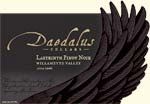 2007 Daedalus Cellars Labyrinth Willamette Valley Pinot Noir 13.0% alc., 620 cases, $45. This wine is a cuvée of some of the best barrels in the cellar in any given vintage. Primarily Pommard clone with some Dijon 114 and Wädenswil clones from old-vine fruit sourced from Seven Springs, Maresh and Murto vineyards and younger fruit from Carabella Vineyard. Cold soaked for 7 to 32 days, 15% whole cluster fermentation, processed entirely by gravity, total skin contact 17 to 42 days, aged 14 months in 28% new French oak, unfined and unfiltered. · Aromas of toasty oak, hay, earth and barnyard dominate the demure dark fruits. The wine has a tasty core of black cherries and black raspberries with an underlying woodiness and a touch of citric peel on the persistent finish. The tannins are reigned in nicely. This wine should improve in the bottle over the next several years.
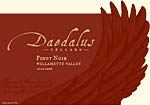 2006 Daedalus Cellars Willamette Valley Pinot Noir 13.0% alc., 1,330 cases, $30. A blend of seven Willamette Valley vineyards. 20% whole cluster. Aged 14 months in 17% new, 8% second fill and 75% neutral French oak. Unfined and unfiltered. · Aromas of oak dominate the dark red fruit with secondary notes of hay and herbs. There is a tasty black cherry and berry attack with a hint of spice. Velvety in texture with supple tannins, ending with a lively tang on the finish that leaves an oak hangover.
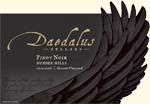 2006 Daedalus Cellars Maresh Vineyard Dundee Hills Willamette Valley Pinot Noir 13.0% alc., 140 cases, $60. Aron has worked with fruit from the Maresh Vineyard since his time at Rex Hill Vineyards starting in 1998 and is his favorite vineyard. Maresh Vineyard is the oldest planting on Worden Hill Road in the Dundee Hills. Yields are naturally low (1 to 1.6 tons per acre). · Very fruity scents of dark red berry compote with oak playing a pleasing supportive role. Luscious and vibrant core of raspberry fruit with a hint of brioche. Harmonious in every way with an unbelievable persistence on the aromatic finish lasting at least 30 seconds. The pedigree of the fruit really shines through. In my experience, it is extremely rare to find a Pinot Noir with such remarkable persistence.
 2005 Daedalus Cellars Nyarady Willamette Valley Pinot Noir 14.1% alc., 220 cases, $60. A blend of the best wine in the cellar from three vineyards: Carabella (Chehalem Mountains) 42%, Maresh (Dundee Hills) 38% and Seven Springs (Eola Hills) 20%. Dijon 114, Pommard and Wädenswil clones. 10 to 17 day cold soak, partial whole cluster fermentation, aged 15 months in 20% new French oak. Unfined and unfiltered. The name of this wine was auctioned to benefit the Jimmy Mancbach Memorial Scholarship Fund. Pablo and Lynanne Nyarady won the bid and named the wine in honor of Pablo’s 85 year-old father. Hess likens this wine to Labyrinth ‘squared,” meaning a little broader shouldered than the Labyrinth bottling. · The floral nose is highly perfumed with violets initially, evolving and becoming more expressive over time to reveal demure dark fruits, spice, oak and fir. Very plush in the mouth with plumy dark fruits, notable oak accents and an underlying earthiness and stemminess. The most striking feature of this wine is its rich and velvety texture.
Lenné Estate: Nose for Pinot NoirLenné Estate was off my radar until recently when Steve Lutz sent me an e-mail proclaiming that his site “produces one of the best American Pinot Noirs you have never heard of.” Steve along with his wife Karen are partners with eleven other investors in HLC Wines LLC, formed in 2002 to develop a wine brand from the 20.9- acre vineyard near the town of Yamhill, Oregon, owned by Steve and Karen Lutz. The first two vintages of Pinot Noir from the estate were released under the LeNez label, and in 2006, the Lenné Estate label was added. All the wines under the Lenné Estate label represent the best barrels from the vineyard in each vintage. Lenné sounds French but the truth is the name is derived from Steve’s father-in-law, Len, who raised his family, including Steve’s spouse Karen, on a chicken farm west of London, England. Len passed away in 1999, but he contributed part of the down payment on Lenné so it seemed only natural to honor him. The Lenné Estate Vineyard is located in the Yamhill-Carlton District on low vigor sedimentary and volcanic soils. The neighborhood is flush with famous names like WillaKenzie Estate, Deux Vert Vineyard, Shea Wine Cellars & Vineyard, Solena Cellars, Soter Vineyards and Beaux Freres. In 2001, Steve Lutz and another partner in HLC Wines, Scott Huffman, worked together at Anne Amie and first laid out the vineyard and planted the first 10 acres of Pinot Noir (clones 115, 777 and Pommard). The two had searched for the perfect site since 1999. Vine spacing was 7’ x 3’ and the vineyard was dry-farmed from the start. The steepness of the site was among several challenges met with and nearly 35% of the vines were lost the first year. In 2003 an additional 2.5-acre block of Pommard was planted but succumbed to the record heat that year and most vines were lost. In 2004-2005 the block was replanted along with an additional 2.5-acre block of Dijon 114 and 667. In 2006 the first wine, the 2004 LeNez Pinot Noir, was released.
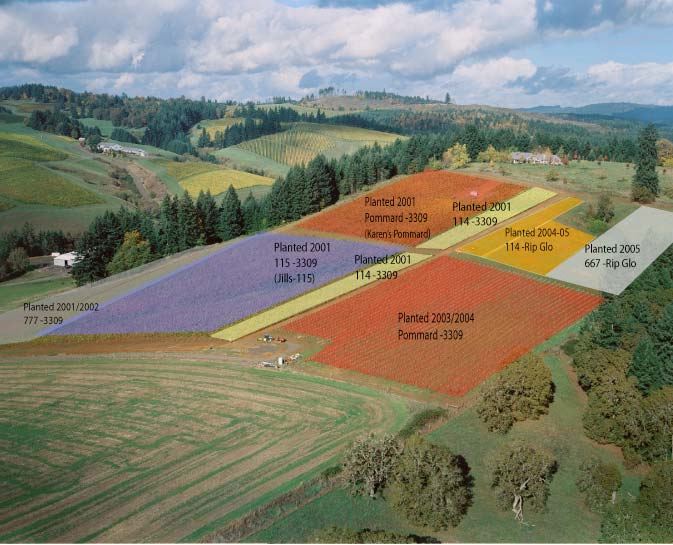 I tasted two vintages from Lenné Estate and they clearly reflect the vintage variability that is quite visible in Oregon Pinot Noirs in 2006 and 2007. The 2006 Pinot Noirs displayed a terrifically rich mid palate but for my taste the fruit was too ripe, reflecting the very warm growing season. The wines displayed raisin and port flavors but did not cross the line to prune. The 2007 wines were distinctly more classic Pinot Noir with more elegance, restraint and acidity and were among the best I have sampled from Oregon in 2007. Both vintages were well crafted and harmonious: 2007 was more Pinot, 2006 was more Noir. It really comes down to personal taste. Steve told me that he has found that 90% of consumers clearly prefer the 2006 vintage wines over the 2007 wines. The 2007 vintage was a challenge and Steve told me, “The best decision I ever made was to let the grapes hang in 2007. We all knew the rain was coming and many people were panic picking. I was sitting at 23.5º to 24º Brix and really had to think hard. Fortunately, David O’Reilly told me not to panic, informing me that my site would ride the rain out just fine and recommending waiting in the name of flavor development. He was right. I didn’t panic and we picked at the same sugar levels but with much greater flavor after two weeks of showers. Steep, windy and warm sites seemed to do the best in 2007.” The Lenné Estate Pinot Noirs are sold through a mailing list and are also available on the website at www.lenneestate.com. The tasting room at 18760 NE Laughlin Road in Yamhill is open from 12:00 to 5:00 weekends or by appointment (503-956-2256). Wines from Lenné’s consulting winemaker, David O’Reilly (Owen Roe) are also poured. Currently there is an investment opportunity at Lenné Estate allowing the investor-partner to enjoy the property and become closely involved in brand development (contact Steve at steve@lenneestate.com). Besides the wines tasted below, there is a Lenné Estate Jills 115 Pinot Noir consisting of the two best barrels of 115 clone ($68).
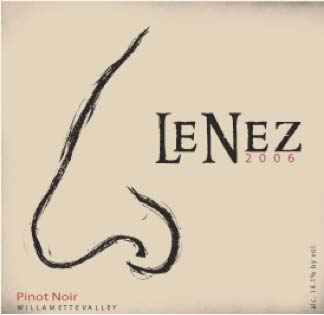 2007 LeNez Willamette Valley Pinot Noir 14.0% alc., $30. The “infant wine of Lenné Estate.” Contains each of the five clones of Pinot Noir grown on the Estate Vineyard. · Very appealing cherry, spice and herbs which expand with time in the glass. Mid-bodied raspberry, cherry and currant fruit flavors that are fresh and vibrant with fine-grain tannins. A touch of heat surfaces at the end. Upfront and enjoyable.
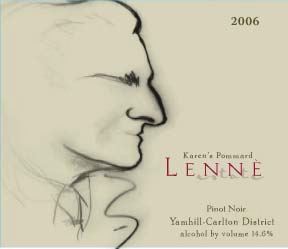 2007 Lenné Estate Yamhill-Carlton District Willamette Valley Pinot Noir 14.0% alc., $45. · Noticeably lighter in color than the 2006 version of this wine. A selection of the best barrels in the cellar. Lovely scents of cherries, spice, violets and spicy oak. Succulent dark stone fruits fan out nicely on the palate enhanced by notes of cola, Asian spice, savory herbs and forest floor. Silky textured and perfectly balanced. This wine shows more terroir than the LeNez bottling from the same vineyard. One of the best 2007 Pinot Noirs from Oregon I have tasted this year.
2006 Lenné Estate Yamhill-Carlton District Willamette Valley Pinot Noir 14.6% alc., $45 (sold out). · Very dark reddish-purple in color. Complex aromas of black raspberries, roasted plums, cedar and a feral note. Very ripe fruit flavors of dark berries and raisins which do not cross the line to prune. Hints of root beer and cola add appeal. Well-crafted and harmonious with a silky presence and vibrant acidity on the persistent finish.
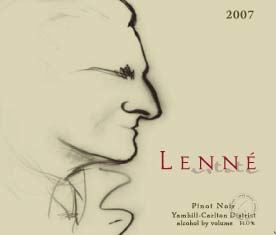 2006 Lenné Estate Karen’s Pommard Yamhill-Carlton District Willamette Valley Pinot Noir 14.6% alc., 49 cases, $68. Two barrels from the best block in the vineyard. · Brooding deep dark fruit jam with a hint of porto and oak on the heavy nose. Big-boned and rich with ultra ripe dark fruit flavors accented by root beer and cream soda. The tannins are toothsome predicting age ability. Similar to the Estate bottling but with all do respect to Karen, more cajones.
J.K. Carriere WinesEstablished in 1999, J. K. Carriere Wines is a Pinot Noir specialist founded by owner and winemaker Jim Prosser. The winery is currently located on a working hazelnut orchard in Yamhill County, but a new winery on Parrett Mountain, three miles east of the current location, is slated to open in the summer of 2009. New estate vineyards are also planned. The name J.K. Carriere is a combination of Jim’s grandfathers names, J.K. Prosser and Paul Carriere.
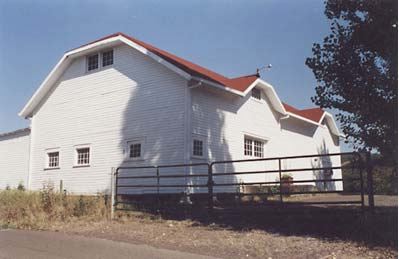 Prosser has a very distinct winemaking style focusing on elegant, high acid, smooth tannin Pinot Noirs capable of aging. Can you say Burgundy? His wines are often lacking in user friendliness until they reach 5 to 6 years of age. Jim is good at tag lines and two of his best are, “Pinot Noir is a tuning fork for the soul,” and “We believe the variety is Pinot Noir....not Merlot Noir.” Prosser is no ordinary winemaker. Like many of his profession, he started out in other fields, working for Xerox and dabbling in commercial real estate. He has traveled five continents, lived in Lituania as a business advisor for the Peace Corps and cycled the United States. Never one to shy away from risky activities, he is also an accomplished snowboarder, snow skier and fly fisher. A few years back, he was pictured in Food & Wine coated in snow and grinning while drinking some very cold Pinot Noir. In 2004 he was included as one of the “25 Coolest People Now” in Outside Magazine. He learned winemaking working for eight producers in four countries including Erath, Domaine Drouhin, Brick House and Chehalem in Oregon, Villa Maria in New Zealand, Tarra Warra in Australia, and Domaine Georges Roumier in Burgundy. The soul of J. K. Carriere Pinot Noirs are the vineyard sources and they are among Oregon’s finest: Chehalem’s Corral Creek Vineyard, Shea Vineyard, Anderson Family Vineyards, Temperance Hill Vineyard, Momtazi Vineyard, Gemini Vineyard, Brick House Vineyard and Stony Mountain Vineyard. Production was less than 3,000 cases for the 2006 vintage. The wines are sold through a mailing list and directly from the website at www.jkcarriere.com. Since Prosser is a firm believer in aging Pinot Noir for maximum enjoyment, he bottles each one of his Pinot Noirs in magnums. I applaud this. Prosser crafts a unique White Pinot Noir fashioned like a rosé Champagne without the bubbles that is hugely popular ($20) and a value play Pinot Noir called the Provocateur ($24). His label is the only one I know of that features a prominent wasp. Prosser is deathly allergic and has twice ended up in a near-coma working in the vineyards. The winery is open for Oregon’s traditional Memorial Day and Thanksgiving weekend open houses with weekend hours in the summer before harvest and by appointment as time permits. 503-554-0721. The winery is located at 30295 Highway 99 W, Newberg, Oregon.
2006 J.K. Carriere Wines Willamette Valley Pinot Noir 13.7% alc., $42. · Dark reddish-purple color. Dark ripe fruit showing some port aromas and flavors but not prune. Light in weight yet offering a modestly rich mouth feel, supple tannins and a refreshing acid lift on the finish. Perfectly fine and a clear reflection of the vintage. Approachable now but will last.
2006 J.K. Carriere Wines Antoinette Willamette Valley Pinot Noir 13.75% alc., 148 cases, $65. Antoinette was Prosser’s maternal grandmother. Sourced from 27 year-old vines in Temperance Hill Vineyard, the oldest from this vineyard. Wild yeast fermentation, aged 18 months in 6 French oak barrels, 2 new, 2 twice-filled and 2 neutral. Unfined and unfiltered. · Deeply colored. Dark fruits tending toward raisin with aromas of smoke, oak and a bit of good barnyard. On the palate there is plenty of satisfying oak-wrapped dark fruit which is shy and restrained. Currently the tooth-sticking tannins and hi-tone acidity overshadow the fruit. Not extremely charming or approachable yet but patience will pay dividends down the road (Prosser predicts a potential life of 12 to 20 years).
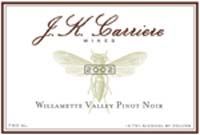 2006 J.K. Carriere Wines Gemini Vineyard Willamette Valley Pinot Noir 13.75% alc., 64 cases,$65. The vines are 15-year-old, Scott Henry trained, Pommard clone Pinot Noir planted in Laurelwood soil. Small lot wild yeast fermentations, aged 18 months in 3 barrels, one once filled, one twice-filled and one neutral. Unfined and unfiltered. · The nose is quite alluring as it expands in the glass over time revealing dark red stone fruits, especially black cherries, spice, oak and marzipan. Hearty core of red and black raspberries and cherries engulfed by flamboyant tannins. Two days later this wine was sampled from a previously opened and re-corked bottle and it was drinking beautifully, smoothly textured with more integration of tannins and more expressive fruit. The lesson here is to decant if you have to drink this wine now, but you would be well advised to keep your hands off of it for at least five years. It’s got backside 9s on lock.
Two Hot Years for Shea Wine CellarsShea Vineyard dates to 1989, one of the first vineyards planted to Pinot Noir in the now esteemed viticultural area known as the Yamhill-Carlton District AVA of the Willamette Valley. Shea Vineyard is now surrounded by many premier Pinot Noir plantings including those of Willakenzie, Patricia Green, Penner-Ash and Beaux Freres. The vineyard today consists of 200 hillside acres of which 135 acres are planted to Pinot Noir and 5 acres to Chardonnay. The vineyard faces south and is divided into two hills, named East and West, separated by a valley containing native plants and trees. The soil found at Shea Vineyard is characterized by shallow sedimentary Willakenzie topsoil with underlying fractured sandstone subsoil. The Pinot Noir plantings are divided into 33 blocks, consisting of numbered blocks 2 to 14, 19 to 27, 30 to 33 and named blocks North, South, Oak Lane, Back, Dierdre’s (formerly 28 and 29), Michael’s (formerly 16) and The Terrace. See the map below for reference.
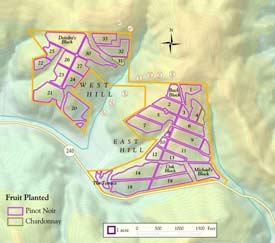 The original plantings of Pommard and Wädenswil clones were on their own roots and inevitably, phylloxera afflicted the vines and planned replanting progressed through 2005. The newer plantings include Dijon clones 114, 115, 777 and 828. Grapes from this distinguished site are highly sought after by many of Oregon’s top wineries. Since 1996, Dick Shea has had his own label, Shea Wine Cellars. There have been several different winemakers to date, but the wines have been consistently excellent displaying a dark red and black fruit character, earthiness and a substantial structure now recognized as typical for the Yamhill-Carlton district. The Shea Wine Cellars Pinot Noirs are designated as Estate ( a blend of several blocks), block-designates which vary from year to year, and a special reserve wine labeled “Homer.” Dick Shea is a baseball fan but in no way connected to Shea Stadium in New York. Dick’s spouse, Deirdre, often compares Dick to Homer Simpson so the name “Homer” has a dual meaning. This cuvée us from the best barrels in the cellar and is the most voluptuous of the lineup, needing several years to reach its prime drinking window. I recently sampled Shea Wine Cellars Pinot Noirs from two very warm recent vintages in Oregon: 2003 and 2006. My reviews are very flattering and deservedly so. The 2003 vintage Pinot Noirs are not for the timid. They are all big wines, darkly colored and intensely flavored. Some wines show overripe fruit with port and prune features. The 2006 vintage is more appealing to me with better acidity and less roasted fruit flavors. Shea Wine Cellars Pinot Noirs and Chardonnay are sold to an enthusiastic mailing list at www.sheawinecellars.com and a limited number of retailers including Avalon Wine in Corvallis (www.avalonwine.com). The winery and vineyard are not open to public. 503-241-6527.
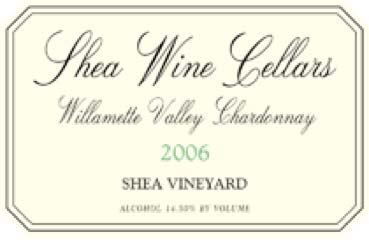 2006 Shea Wine Cellars Shea Vineyard Willamette Valley Chardonnay 14.5% alc., 381 cases, $35. Shea Vineyard blocks 4, 21, and 31. Cropped at 2.19 tons per acre. Dijon 76, 548 and 95 clones. 100% barrel fermented, 100% MLF. Aged 10 months in 13% new and 87% previously filled Burgundian oak barrels. · This Chardonnay has the charm of a barrel fermented Chardonnay without the over-the-top oak and butter treatment. Delicate yellow color. Fresh and lively flavors of citrus fruits, pears and vanilla with an undercurrent of minerality and a refreshing finish that makes you want to reach for another sip.
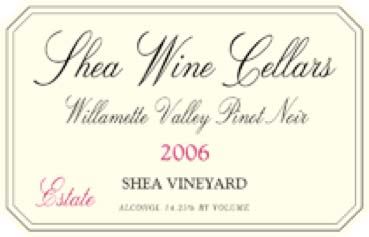 2006 Shea Wine Cellars Estate Shea Vineyard Willamette Valley Pinot Noir 14.25% alc., 2,500 cases, $45. Fruit for this wine is sourced from the entire vineyard (blocks 5,7,13,19,20,21,22,23,24,25,28,29,32 and Oak) and includes several Dijon clones and Pommard and Wädenwsil clones. Cropped at 2.21 tons per acre. 4% whole cluster. Aged 10 months in 49% new and 51% previously filled Burgundian barrels. · A dark fruited wine showing black cherries and black raspberries with a subtle vein of oak, dry herbs and toast running through. Firm in structure, soft in texture with supple tannins. Not as interesting as the other 2006 Pinot Noirs but still very decent.
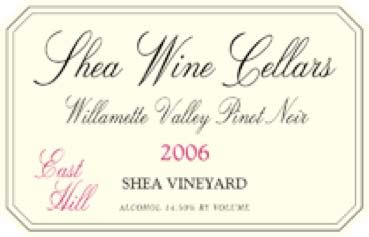 2006 Shea Wine Cellars East Hill Shea Vineyard Willamette Valley Pinot Noir 14.5% alc., 320 cases, $52. From block 7, , 13 and Oak. Cropped at 2.33 tons per acre. Clones are Wädenswil (25%)and Dijon 114, 115 and 777 (75%). 2% whole cluster with a high amount of whole berries. Aged 10 months in 63% new and 37% previously filled Burgundian oak barrels. · Assertive scents of red and black berries, spice, oak and a little good barnyard. Mouth-coating red and black fruits which fill the mid palate with pleasure. Thoroughly refreshing due to bright acidity and a touch of citrus zest on the persistent finish. Vivid, elegant and perfectly harmonious.
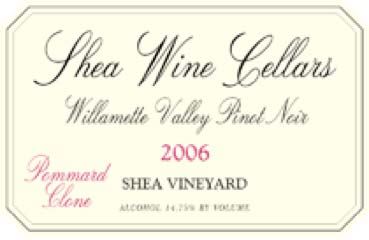 2006 Shea Wine Cellars Pommard Clone Shea Vineyard Willamette Valley Pinot Noir 14.75% alc., 246 cases, $52. Vineyard blocks 32, 33 and 34. Cropped at 2.04 tons per acre. 4% whole cluster. Aged 10 months in 55% new and 45% previously filled Burgundian oak barrels. · Dark red raspberries, herbs and a little barnyard on the slightly reserved nose. Rich deep red stone fruits are lushly flavored and lifted with oak spice. Velvety in the mouth with moderate wooly tannins and a dry finish. Very tasty.
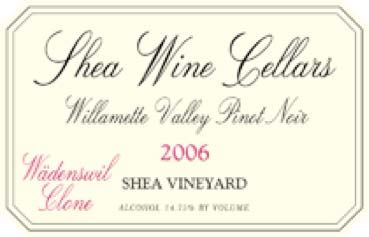 2006 Shea Wine Cellars Wädenswil Clone Shea Vineyard Willamette Valley Pinot Noir 14.75% alc., 236 cases, $52.Shea Vineyard blocks 25, 28 and 29. Cropped at 1.98 tons per acre. 14% whole cluster. Aged 10 months in 43% new and 57% previously filled Burgundian oak barrels. · Brooding dark fruits on the nose annotated with dark chocolate, herbs and a whiff of heat. A big wine that is still somewhat closed with the fruit submerged in a prodigious structure. Noticeable roundness and a velvety mouth feel from the alcohol. Still has some tannins to shed. Hold on to this one for 3 to 5 years.
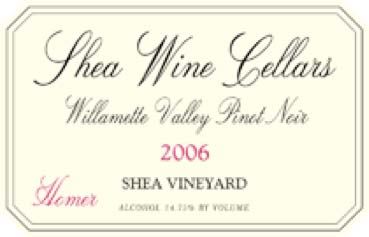 2006 Shea Wine Cellars Homer Shea Vineyard Willamette Valley Pinot Noir 14.75% alc., 253 cases, $75. Blocks 7, 32, 25, 28 and 24, Wädenswil and Pommard clones cropped at 2.17 tons per acre. 15% whole cluster with a high amount of whole berries. Aged in 82% new French oak. Ten of the finest barrels in the cellar. · Surprisingly forward for a Homer bottling. Lovely aromas of dark fruits with hints of floral perfume, roasted nuts, and oak. Red plums and dark berries are dense and plush on the palate. Very smooth with polished tannins. Remarkable lift of berry aromas on the lithe and endless finish. A Pinot to envy.
2003 Shea Wine Cellars Estate Shea Vineyard Willamette Valley Pinot Noir 14.8% alc.. · The aromas are ripe and fruity featuring black raspberries, black cherries, black currants with a slightly roasted or cooked profile. Dense and chewy dark fruits are almost Syrah-like. The texture is silky and the fuzzy tannins are soft and unobtrusive. A victim of the warm vintage.
2003 Shea Wine Cellars Block 23 Shea Vineyard Willamette Valley Pinot Noir 14.2% alc., 275 cases, $48. From 3.2 acres planted in 1990. Self-rooted, non-irrigated Pommard clone that is part of the original Shea Vineyard plantings. · The nose shows the typical “Sheaness” aromas of black cherries, violets and earthiness. Generous compliment of dark cherries and strawberries which persist on the endless finish. The texture is pure silk. Still showing plenty of dry tannins and will last several more years. Best wine of the 2003 lineup and much better than a bottle of the same wine tasted last year.
2003 Shea Wine Cellars Block 32 Shea Vineyard Willamette Valley Pinot Noir 14.8% alc., $48. Wädenswil clone from original plantings. · A stylish nose of black cherries, violets, earth, smoke and subtle oak. Tasty and lipsmacking black raspberry and blackberry fruit. Moderate tannins give the wine density.
2003 Shea Wine Cellars Homer Shea Vineyard Willamette Valley Pinot Noir 14.9% alc., 145 cases, $65. Composed of the finest barrels in the cellar. Dijon clone 115 and Wädenswil. · Reserved aromas of cherries and fresh berries with hints of herbs, oak and funk. Meaty fruit flavors are brooding. A touch of smoke and oak adds interest. Moderate tannins and a touch of heat surface at the close.
Just for the heck of it I blended the 2006 Pommard and 2006 Wädenswil Pinot Noirs in a 50/50 proportion. The result was quite appealing. Dark and fruity with some brown sugar notes, very smooth in texture with a clean finish. I preferred this over the Wädenswil clone bottled alone. The 2007 vintage Shea Wine Cellars Pinot Noirs and Chardonnay have just been released. Autumn rains arrived early in 2007 but the grapes at Shea Vineyard ripen early and most of the fruit was ripe and picked before the onset of rain. In 2007 there are five Pinot Noirs: Estate ($45, 4,075 cases), East Hill ($55, 340 cases), Pommard Clone ($55, 290 cases), Block 33 (a new wine from Shea Wine Cellars, $64, 97 cases) and Homer ($82, 333 cases). The Chardonnay is sensibly priced ($35, 367 cases).
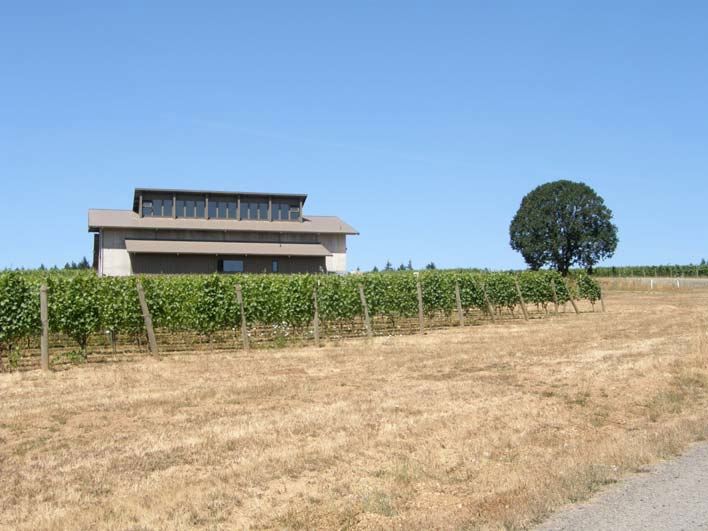
Dobbes Family EstateUnlike many winemakers and winery owners who have immigrated from California to seek the grail of Pinot Noir in Oregon, Joe Dobbes is a native Oregonian, raised in a small town in the northern Willamette Valley and educated in Ashland. Joe did receive his early winemaking inspiration in Germany and France, apprenticing at Wiengut Erbhof Tesch in the Nahe region of Germany and at Domaine Georges Roumier and Domaine Comtes Lafon in Burgundy. Returning from Burgundy in 1989, he became the winemaker at Eola Hills Cellars and later Hinman Vineyards. In 1996 he joined Willamette Valley Vineyards as winemaker where he also produced wine under the Griffin Creek and Tualatin Estate labels. In 2003 he created three of his own distinct labels under the Wine by Joe, LLC banner: Dobbes Family Estate high-end premium Oregon varietal wines including Willamette Valley Pinot Noir and Pinot Gris and Rogue Valley Syrah and Viognier); Wine by Joe, a second label producing value priced Pinot Noir, Pinot Gris and Pinot Blanc bottled under screw top and intended for “Monday thru Thursday consumption”; Jovino Oregon Pinot Noir, a food-friendly wine intended to be served at restaurants. In February of 2006, Wine by Joe, LLC became one of the largest vineyard holders in Oregon with the acquisition of the 214-acre Larkin Estate Vineyard is located in the Willamette Valley AVA in Polk County, approximately 10 miles west of Salem. A total of 189 acres are planted to Pinot Noir (80 acres), Pinot Gris (82 acres) and Pinot Blanc (27 acres). Joe is pictured below with his family (Joe, Patricia, Amelia and Griffin). The Dobbes Family Estate Pinot Noirs are bold and gutsy. The 2006 wines reflect the vintage with fruit reflecting the hot weather at harvest. The mark of the wines regardless of vintage is craftsmanship and all the wines are beautifully composed. Dobbes Family Estate wines are sold on the website at www.dobbesfamilyestate.com. The tasting room is open Monday through Sunday from 11:00 to 6:00 at 240 SE 5th Street, Dundee. 503-538-1141.
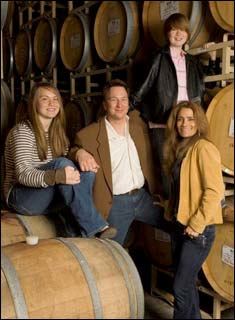
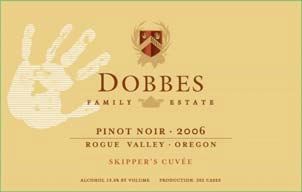 2006 Dobbes Family Estate Skipper’s Cuvée Rogue Valley Pinot Noir 13.5% alc., 202 cases, $42. Skipper is Joe’s daughter Amelia’s nickname. Sourced from vineyards located at 2,000 feet above sea level in Southern Oregon’s Rogue Valley. This unique vineyard has daytime temperatures as high as 96 degrees and nighttime temperatures as low as 35 degrees. The vineyard was farmed to 3 tons per acre. Clones are Dijon 115 and 777. 25% whole clusters. Indigenous yeast. Racked twice before bottling 15 months later. Aged in 40% new French oak. · Moderately light garnet in color. Ripe fruit aromas tending toward port and raisin. Cherry and berry core marked by root beer and baking spice. Overripe flavors but nicely crafted and will find fans who welcome the elegance.
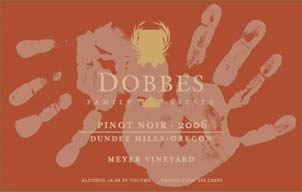 2006 Dobbes Family Estate Meyer Vineyard Dundee Hills Willamette Valley Pinot Noir 14.4% alc., 42 cases, $65. Clone 777. The vineyard was farmed to 2.10 tons per acre. 100% de-stemmed. Aged 11 months in 50% new French oak barrels. · Penetrating aromas of dark raspberries, black cherries, raisins, grapes and oak which build in the glass and becomes almost orgasmic. My notes say Wow! Smelled great! Delicious dark red fruits fan out nicely on the palate caressing the tongue with softness. Tobacco and raisin flavors add interest. Fine tannins and a citrus tang on the finish. I kept coming back to explore this interesting wine which was unique in its aromatic and flavor profile.
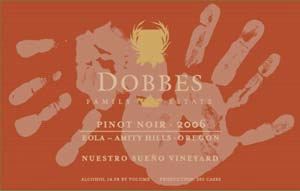 2006 Dobbes Family Estate Nuestro Sueño Vineyard Eola-Amity Hills Willamette Valley Pinot Noir 14.2% alc., 202 cases, $65. The dry-farmed 16- acre vineyard name means “our dream” in Spanish and is owned and tended by Celeste and Tom Symonette. Clones are Dijon 114, Pommard and Wädenswil. The vineyard was farmed to 2.10 tons per acre. Racked twice before bottling. Aged in 40% new French oak. · On the nose there are slightly roasted dark fruits, raisins and porto. Slightly sweet roasted plum, berries, and raisins on the palate. Solid fruit core but slightly overripe. The tannins are moderately demonstrative.
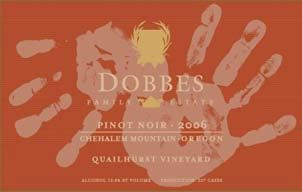 2006 Dobbes Family Estate Quailhurst Vineyard Chehalem Mountains Willamette Valley Pinot Noir 13.8% alc., 237 cases, $65. This vineyard is farmed by Marvin and Deborah Hausman. Dobbes Family Estate has a monopoly on all of the fruit available for sale from this vineyard and this wine is the first vineyard-designated Pinot Noir offered by another winery. The vineyard was farmed to 2.10 tons per acre. 100% de-stemmed with 70% whole berries intact in the fermenter. Racked twice before bottling and aged 11 months in French oak. · Slightly reduced aromas of dark stone fruits, dark chocolate, charred oak and smoke. Lovely black cherry and berry fruit liquor attack the palate and coat every nook and cranny in the mouth. The fruit is ripe but stops short of overripeness. The flavors are stunning, close to a slightly sweet and tart freshly baked cherry pie with a perfect crust and a hint of nutmeg spice. Everything is in harmony with supple tannins and a tangy finish. A distinctive wine with great charisma.
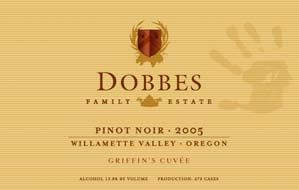 2005 Dobbes Family Estate Griffin’s Cuvée Willamette Valley Pinot Noir 13.8% alc., 273 cases, $42. Blended from five vineyard lots and hand selected barrels. Clones 113, 115, 667, 777 and Pommard. Cropped at 2 tons per acre. 100% de-stemmed with about 70% whole berries intact in the fermenter. Racked twice before bottling 18 months later. Darkly colored. · Very earthy nose with restrained scents of dark fruits, herbs and hi-toned oak. A masculine wine with both red and black fruits that is somewhat linear but drinks nicely. Rich in texture with a dry finish featuring a lingering citrus note. Well-made.
 2005 Dobbes Family Estate Cuvée Noir Willamette Valley Pinot Noir 13.5% alc., 277 cases, $52. This is wine a blend from the finest vineyard lots and favorite barrels. Vines cropped at 2 tons per acre. 100% de-stemmed with about 70% whole berries intact in the fermenter. 6 day cold soak. Indigenous yeast. Racked twice before bottling 18 months later. · Dark reddish-violet color. Huge nose that really seduces you featuring dark raspberries, blackberries, oak and flowers. A gutsy wine with a rich mid palate showing earth-dusted dark stone fruits and berries with a compliment of oak and a touch of citrus on the pleasing finish. An intense wine for hedonists that can be enjoyed now and should hold up nicely over several years.
Laura Volkman VineyardsLaura Volkman lovingly farms a small Pinot Noir vineyard located in Yamhill County, Oregon. She is fanatical about her vineyard farming, performing practically all the physical work in the vineyard, and for the most part, won’t let anyone else, even her husband, touch the vines. In the winery, she is so intense about her winemaking that she takes every bottle personally. She even does her own punch downs. She likens her passion and dedication to an author writing a great book who seeks a sequestered location and entirely focuses on the job at hand. The Laura Volkman Vineyard is located about a quarter mile from August Cellars in Newberg. This is a cooperative facility in which several winemakers, including Laura, lease space. Together with her husband, she purchased a small farm several years ago, cleared the land and planted the vineyard to clones 114, 115, 667, 777 and Pommard. She developed her winemaking acumen through the Northwest Viticulture Center in Salem, Oregon and was mentored by Mike Etzel at Beaux Freres during the 2001 and 2002 crush. Her first wines were released from the 2004 vintage. The labels are quite striking and display artwork depicting Laura in her vineyard (created by watercolor artist Terry Peasley).
 Both of the 2006 Laura Volkman Vineyards Pinot Noirs (Rachel Estate and Jacob Estate, named after her two children pictured above) knocked it out of the park. I recently sampled her newest release, the 2007 Jacob Estate Pinot Noir and I am happy to report she is still on her game. Her Bella Chardonnay from purchased fruit is a killer as well. The wines are sold through a mailing list at www.volkmancellars.com or by contacting Laura at 503-806-4047. Tasting is available by appointment at the vineyard at 13000 N.E. Quarry Road (off highway 99W) in Newberg.
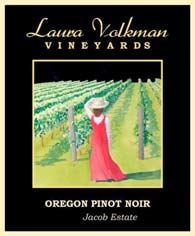 2007 Laura Volkman Vineyards Jacob Estate Oregon Pinot Noir 13.5% alc., 135 cases, $45. Sourced from fruit grown on the East Block of the estate vineyard. Clones are 114, 115 and 777. Barrel aged on the lees in 50% new French oak. · Wonderful aromatics with considerable interest. Red stone fruits and red berries, cinnamon spice, a hint of oak and a touch floral with some fresh mountain air marked by cedar and pine. An aromatic wine on the palate with lingering flavors of red fruits, oak and edible flowers. Very clean and silky with polished tannins and a good grip on the finish. Perfectly harmonious and a real treat.
Johan VineyardsJohan Vineyards is a relative newcomer in the Oregon Pinot Noir scene, consisting of 65 acres of estate vineyards on a 175-acre site in the southwestern corner of the Van Duzer corridor just west of Salem. Owner Dag Johan Sundby, a native Norwegian, came to North America in 2004 to work with Ray McCall, an old friend and business partner of his father, Nils Dag Sundby. While Sundby and McCall frequently played golf together, it was the times enjoying Pinot Noir from many prominent Oregon wineries that left an impression on Dag and led him to partner with his father in founding Johan Vineyards. Johan Vineyards’ viticulturist and winemaker is Daniel Rinke, who holds a Bachelors Degree in Viticulture from California State University Fresno. His training included stints at Domaine Alfred in Edna Valley and Rhys Vineyards in the Santa Cruz Mountains. In 2007 he joined Johan Vineyards as vineyard manager and winemaker. The estate vineyards are farmed organically and biodynamically. Plantings include Pinot Noir, Chardonnay and Pinot Gris. 95% of the estate grapes are sold to other premium wineries. The first Pinot Noir was released in 2005. The current case production of estate grown and bottled wines is 1,000 cases, moving towards 2,500 cases in the future. I recently sampled the 2006 Johan Vineyards Pinot Noir and was very impressed. This is a new hound in the race worth betting on. The Johan Vineyards Pinot Noir was chosen to be poured at this year’s World of Pinot Noir. The wine is available for sale on the website at www.johanvineyards.com.
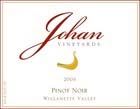 2006 Johan Vineyards Willamette Valley Pinot Noir 14.5% alc., 670 cases, $35. Clones 115, 667 and 777.33% whole cluster fermentation, indigenous yeasts. Aged 16 months in 60% new French oak and bottle aged another 7 months before release in August 2008. · Moderately light garnet color. Very alluring aromas of freshly crushed berries, oak and allspice. Full compliment of sweet berries on the palate with impressive richness and length. Appealing riffs of oak and savory spices. The wine reflects the 2006 vintage with its plush fruit profile but overripe fruit is not an issue. Very friendly in the mouth and easy to recommend.
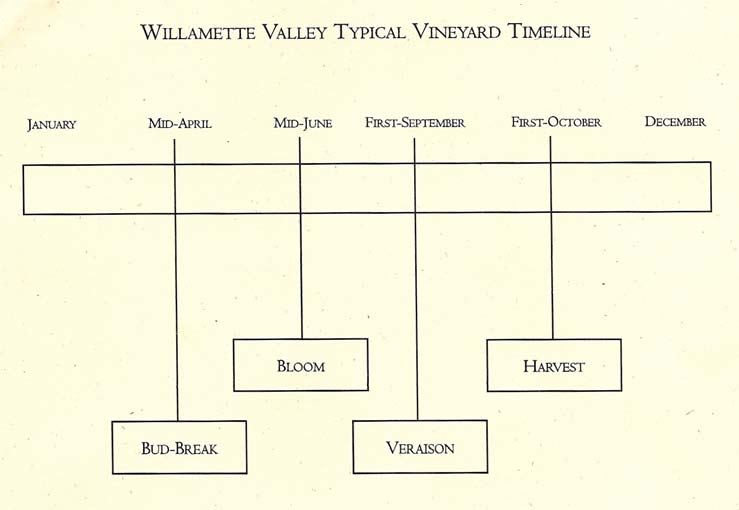
Small Sips of More Pinot 2007 Westrey Wine Company Justice Vineyard Eola-Amity Hills Willamette Valley Pinot Noir 13.5% alc.,$27. From Bethel Heights’ Estate Justice Vineyard. · he nose is shy on fruit, emphasizing grass, hay, and oak. Demure wood-kissed red fruits on the silky attack. A very light and feminine Pinot Noir with ample acidity and gossamer tannins that will allow it to perform well at the dinner table.
 2007 Lange Estate Winery & Vineyards Reserve Willamette Valley Pinot Noir 13.5% alc.,1,300 cases, $32. Composed of the best barrels from multiple vineyards. Aged 10 months in 30% new French oak barrels. Don and Jesse Lange are the winemakers. · Red-fruited nose with compliments of seasoned oak and herbs echoed in the flavors. Juicy with lively acidity and moderate fine grain tannins. Much better when tasted the next day from a previously opened and re-corked bottle. Short-term cellaring is advised.
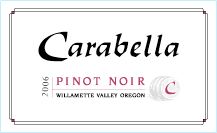 2006 Carabella Chehalem Mountains Willamette Valley Pinot Noir 14.7% alc., 1,800 cases, $39. From six blocks of the Carabella Vineyard planted to Dijon, Pommard and Wädenswil clones. · Demure aromas of red plums, cherries, minerals and exotic spice. Silky entry of tasty raspberry and strawberry fruits which are vivid and pleasing. Admirable grip on the clean finish. Very easy to like and immensely satisfying. Drink this one while you wait for the Inchinnan to develop.
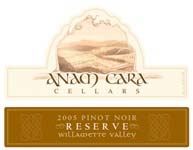 2006 Anam Cara Cellars Nicholas Estate Reserve Chehalem Mountains Willamette Valley Pinot Noir 15.0% alc., $45. Blended from ten select barrels in the cellar. · Very fragrant berry fruit with a hint of toasted oak. Dark garnet color. Delicious black raspberry and blackberry core of fruit that dances and cascades smoothly through the palate. A touch of anise, tea and oak adds interest. A big wine with glassfilling presence that leaves a little heat on the back end.
 2006 Carabella Inchinnan Chehalem Mountains Willamette Valley Pinot Noir 14.9% alc., 250 cases, $54. The Carabella Vineyard is part of the Inchinnan Farm, the hazelnut orchard still owned by the McDonald family and this cuvée honors the McDonald’s support. Seven blocks of Pinot Noir fermented separately. Dijon 114 and 115, Pommard and Wädenswil clones. The winemaker is Mike Hallock. · This wine needs plenty of time to open up and I would recommend decanting if you want to pop the cork now. Shy raspberry fruit nicely oaked on the nose. Richly layered berry and dark stone fruits with riffs of earth and meat. Smoothly textured and harmonious with good integration of the alcohol. The wine keeps opening and opening, teasing and seducing the drinker slowly. A fine waltz.
Pinot Gris: Oregon’s Signature White WineThe Pinot tribe is very old and its true origins are lost in time. Pinot Noir was cultivated in the region now known as Burgundy before the arrival of the Romans and according to Carol Meredith of University California Davis, is probably only one or two generations removed from wild vines. It has been proposed by researchers in Austria that Pinot Noir is a cross between Pinot Meunier and Traminer but this is unlikely. Rather, Pinot Meunier appears to be a chimera, that is, a mutation in the epidermal (outer) cells creating two tissue layers of different genetic makeup with the inner layers genetically identical to Pinot Noir. Pinot Noir has a proclivity to mutate and both Pinot Gris and Pinot Blanc are mutations of Pinot Noir with DNA profiles that are identical to Pinot Noir. The leaves, clusters and vines of Pinot Gris and Pinot Noir are so much alike that the only thing to distinguish them is the coloration difference. Pinot Gris is a white variety of wine grape with skins that can vary in color from grayish-blue (“gris” means “gray” in French) to rose or pink or even white. The wines produced from Pinot Gris are usually varying shades of yellow but can take on shades of copper or pink. If Pinot Noir is a red grape masquerading as a white grape, as is often quoted, then the opposite would be true of Pinot Gris.
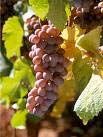 Pinot Gris was known to exist from the Middle Ages in the Burgundy region and spread to other parts of Europe from there. Over time, it has been successfully propagated throughout the world where it has taken on a number of different local names and synonyms: Pinot Beurot in Burgundy and the Loire Valley, Malvoisie in the Loire Valley and Switzerland, Auxerrois Gris in Alsace, Fromentau in Languedoc, Tokay d’Alsace (now renamed Pinot Gris) in Alsace, and Pinot Grigio in Italy. In the last 20 years, Pinot Grigio has become wildly popular in the United States, probably because the name is foreign yet rolls easily off the American tongue and the Pinot Grigio style of wine from Italy is light, crisp, sometimes spritzy and easy to drink.
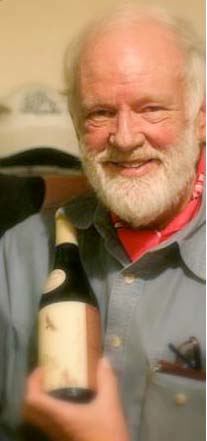 Last year the Oregon wine industry lost David Lett, an icon who passed away after a long and distinguished career as a winegrower and winemaker in the Willamette Valley. He was affectionately referred to as “Papa Pinot,” since he was the first to plant Pinot Noir and Pinot Gris in the Willamette Valley in 1966. The story goes that Lett began marketing Pinot Gris as a perfect wine match to salmon, christening it “salmon wine,” and the popularity of the wine slowly evolved in Oregon. In Jancis Robinson’s classic book, Vines, Grapes and Wines, published in 1986, she noted that Pinot Gris” was practically ignored in the New World.” It wasn’t until the 1990s (as winemaker Scott Shull points out below) that Oregon Pinot Gris achieved notoriety. I asked four winemakers in the Willamette Valley who have had experience growing and crafting Pinot Gris to comment about how it has become Oregon’s signature white wine, how it fits into food and wine pairing and how Oregon’s version of Pinot Gris is distinct from Pinot Gris from California and Alsace, France. I have included the responses of Harry Peterson-Nedry of Chehalem, Gilles de Domingo of Cooper Mountain Vineyards, Don Lange of Lange Estate Winery and Scott Shull of Raptor Ridge.
Q: How did Pinot Gris become Oregon’s signature white wine? A: Harry Peterson-Nedry: Pinot Gris has become the most widely planted Oregon white grape due to its versatility and partly by default. It is a variety that performs well in most regions of Oregon, warm to cool, retaining good acid while developing excellent fruit and complexity. It was a variety that wasn’t being grown elsewhere, so carried some Oregon ownership at the time. It also came into vogue at a time when nonserious, sweeter-styled, early wine region Rieslings were in disfavor and when Chardonnay clonal changeover 26 from lackluster clone 108 to richly appropriate Dijon clones had not yet taken place. In other words, the right grape and the right time. A: Gilles de Domingo: In the late 60s, David Lett planted the first Pinot Gris in Oregon by grafting some plants on top of Riesling. Because of the early positive responses, the varietal started to develop at a rapid pace. A: Don Lange: Pinot Gris became a signature wine for Oregon because it is matched to the climate. The success of this grape in Oregon is predicated on the perspicacity of David Lett whose original plantings contain an especially intriguing “clone” of this grape which expresses uncommon depth and complexity. A: Scott Shull: After its first New World planting in 1966 by David Lett, Pinot Gris production was well ahead of the market until the mid 1990s. In the early 1990s, it must be noted that the King Estate planted and bought vast acreage of Pinot Gris in a major thrust to bring this delightful white wine to the national market. It was the combination of Lett’s varietal selection for Oregon’s cool climate and King Estates’ bringing it to critical mass that put Oregon Pinot Gris on the national stage. Q: Some do not consider Pinot Gris a wine connoisseur’s wine. What is the appeal? A: Harry Peterson-Nedry: Some wine connoisseurs DO consider Pinot Gris a connoisseur’s wine. However, it definitely isn’t Riesling or Chardonnay in stature. It has thrived in a climate in the United States where ABC (anything but Chardonnay) gained traction and where food wines were valued more (that is, fruit, more acid, less oak). A: Gilles de Domingo: In Europe, a few Pinot Gris producers have been successful in making full bodied wines with lasting length and complexity. Pinot Gris is genetically very similar to Pinot Noir. This is a wine that needs to be treated similar to Pinot Noir in winemaking practice (except the barrels). Pinot Gris with natural higher acidity will bring a level of complexity fairly unique if the vineyard and winemaking are appropriate. In a certain sense, because of the similarity to Pinot Noir, a very high end Pinot Gris requires considerable time and patience to be made. Soils and climate need to be perfect to achieve this result. Also, Pinot Gris is a varietal that can age very well and for quite a long time. If a varietal is able to be complex, full bodied and age, then it is a varietal that should be considered “Noble.” Unfortunately, the public and even wine connoisseurs tend to see Pinot Gris as a simple varietal because many examples are made in an industrial way and not as a “Noble” varietal with all the beauty and effort of winemaking. A: Don Lange: I’m flummoxed by this question. What, pray tell, is a “wine connoisseur’s wine?” If we assume that, for instance, California Chardonnay is such, then it is safe to assume that Oregon Pinot Gris is as well. When well tended, it exhibits layers of complexity, texture and balance. If overcropped and/or planted in an inappropriate climate it can produce an innocuous but quaffable white wine which is, perhaps, unfit for the connoisseur’s palate. A: Scott Shull: Oregon Pinot Gris is a gateway wine - it is just darn easy going and a great dinner guest. Often it transitions people away from heavy, oaky, white wines toward something with layers of complex citrus fruits, acidity and minerality. I think the appeal of Oregon Pinot Gris is that it complements food rather than competes with it. The style is usually stainless steel fermented and without any malolactic fermentation so the wines remain crisp and articulate, but with a touch of residual sugar that keeps things full and with an accounting of its fruit. Unlike Pinot Grigio, Oregon Pinot Gris has some heft, depth and mineral. Q: How does Pinot Gris fit into the food-wine pairing picture or is it mainly an aperitif? A: Harry Peterson-Nedry: Pinot Gris definitely fills a dinner table rather than an aperitif role. It may indeed be, after Riesling, the most food friendly wine I know, matching with traditional foods such as pork, white meats generally, sausage, rich fish and shellfish, as well as providing a wine for ethnic and spicy cuisine. I consider it a universal food wine, especially in high acid versions. A: Gilles de Domingo: If the Pinot Gris comes from Alsace and even Oregon, I will advise that it be served with nicely made salami. Also Pinot Gris with lamb is terrific. I would also recommend a Pinot Gris from a warmer climate to be served with “light” fish. 27 : Don Lange: Pinot Gris is as versatile with food as is it’s parent Pinot Noir. The classic pairing in the Northwest is with salmon. If in doubt what to serve with dinner, the baseline is to set the table with a glass for Pinot Noir and glass for Pinot Gris. Pinot Gris is its best can suggest orange, lime, ginger, anise with a fetchingly unctuous palate presence. A: Scott Shull: Oregon Pinot Gris is a great food complement with salmon (I particularly like Copper River salmon with Oregon Pinot Gris), or shellfish in cream sauce. If the acid-residual sugar balance is right, those ‘bright’ offerings of Oregon Pinot Gris are fantastic to cool the heat of Indian fare. We love a tandoori with Oregon Pinot Gris. Q: How does Oregon Pinot Gris compare with its California and Alsatian counterparts. What makes it distinctive? A: Harry Peterson-Nedry: Oregon Pinot Gris to my palate is all about freshness of fruit and acid, with pear, apple and kiwi fruit, white blossoms and light baking spices. It carries weight, but not too much, has structure for food, but not too much. Alsace seems to carry more residual sugar and is typically richer with weightier flavors, less on the white side and more on the yellow flavor spectrum. California seems to resemble Oregon in very cool areas like the Anderson Valley and seems flat and Chardonnay-mimicking from other regions. A: Gilles de Domingo: Alsatian Pinot Gris tends to be full bodied and creamy with high levels of complexity. Alsatian Pinot Gris will have “tertiary” aromas because of the high level of esterification. A general description of the aromatic profile of Alsatian and Oregonian Pinot Gris would be described as melon, pears, grapefruit, herbal and flowery. California Pinot Gris is more fruit forward with an intense aromatic profile which is monochromatic. Peach and apricot seem to be descriptive of California Pinot Gris. Because of the DNA composition of Pinot Gris, the varietal requires specific micro and meso terroir such as cool nights, long and lasting period of maturity on the vines without the effect of dehydration. Some California areas have a natural aptitude to grow wonderful Pinot Gris. Northern Oregon tends to be a later ripening season than California and the Pinot Gris as a result tends to have more acid and more aging potential than California versions. Also, Pinot Gris likes acidic soils (pH<6.5). A: Don Lange: New World Pinot Gris originated in Oregon as a result of Lett’s singular dedication to matching the varietal to the climate. Lange Estate was the fourth producer of Pinot Gris in the New World with the first release in 1987. For a period during the 1990s, Lange Estate Winery was the largest producer of Pinot Gris in North America. I do not know of any commercially grown or produced Pinot Gris at the time in California. (Note: According to A Companion to California Wine written by Charles Sullivan, a few acres of Pinot Gris were planted in California in the early 1980s and by 1995 there were 68 acres, more than half in Santa Barbara and Napa counties.) I do know, however, that when winemaker Ken Brown visited us in the early 1990s, he was not familiar with Pinot Gris but became excited about it and soon after planted Pinot Gris in California. Oregon Pinot Gris is distinguished from its California counterparts by its superior acid backbone and focus. Compared to its Alsatian counterparts, Oregon Pinot Gris is more fruit driven. A: Scott Shull: Alsatian Pinot Gris tends to be fatter with more residual sugar and often interesting “funk” from fermentation in decades old foudres. I love that smell of Alsace that you get from the first whiff of an Alsatian Pinot Gris. Oregon Pinot Gris tends to have one foot in the realm of Alsace with a touch of palate weight, and certainly shares that love of balance between residual sugar and acidity. Oregon Pinot Gris is not often perceived as sweet, as many Alsatian versions can be, yet may have residual sugar levels of 0.6% to 1.0% and acidity to match and balance out. Oregon Pinot Gris has an accounting of fresh fruit, yet has length and finish driven by acidity. California Pinot Gris, often marketed as Pinot Grigio, is crisp, clear and clean. David Lett used to talk about Pinot Gris grown on the valley floor at 8 tons per acre versus what we do in Oregon, where most vineyards are on high southern facing slopes, cropped at 2.5 to 3 tons per acre. You get fruit, fat and finesse.
In summary, several features of Pinot Gris wines become clear:
*The aroma and flavor profile of Oregon Pinot Gris includes honey, pear, apple, mango, kiwi, citrus, spring flowers including honeysuckle and light baking spices. *A small amount of residual sugar in Oregon Pinot Gris is not unusual. It balances the acidity nicely and is frequently not detectable. *Oregon Pinot Gris wines are fresh with bright acid and although usually consumed shortly after release, some versions are capable of aging. *Oregon Pinot Gris has more fruit, weight, structure and complexity than most Italian Pinot Grigio. *Oregon Pinot Gris is inexpensive with the best examples under $20. Many are closed with screw caps and some are bottled in tall Alsatian-style bottles. *The ideal serving temperature is 50-55º F. At this temperature the wine will have more aroma, brighter acidity, a richer flavor and mouthfeel. In restaurants, Pinot Gris is often presented much too cold. If this is the case, ask the wait staff to put your glass of Pinot Gris in the microwave for 10 seconds. Forget the ice bucket unless the wine is room temperature and needs to be cooled. *If you drink no Gris, you Pinot Gris.
Particularly noteworthy:
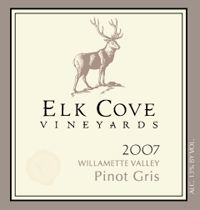 2007 Elk Cove Vineyards Willamette Valley Pinot Gris 13.0% alc., 18,420 cases, $19. From vines that are 7-22 years of age cropped at 3.2 tons per acre (shoot and crop thinned for low yields). Whole cluster pressed and fermented at very cool temperatures in small stainless steel tanks. · Complex aromatic profile of pears, biscuit, honey and wax. Bright pear and apple fruits with a creamy richness, lively yet well-integrated acidity and a persistent finish. This is the one to try if you want to experience what Oregon Pinot gris is all about.
 2007 Willakenzie Estate Willamette Valley Pinot Gris 13.8% alc., 5,684 cases, $18, screw cap. Estate grown. · Delicate aromas of pear, melon and citrus echoed in the flavors. Perfect balance of richness and acidity with a lingering aromatic finish.
Perfectly fine:
2006 Carabella Chehalem Mountains Willamette Valley Pinot Gris 13.8% alc., 1,780 cases, $16. Sourced from 11 acres of estate dry farmed Pinot gris. · Slightly deeper yellow color than many examples. Shy aromas of pear and minerals. A bit atypical in flavor profile featuring roasted nuts, miso and honey. Very smoothly textured.
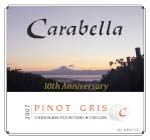 2007 Carabella Chehalem Mountains Willamette Valley 10th Anniversary Pinot Gris 12.4% alc., $17. · Delicate and attractive scents of pears and honeysuckle. Bold pear flavor on the attack with hints of apple and citrus. Creamy with a tangy finish that features fine persistence.
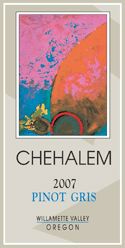 2006 Chehalem Willamette Valley Pinot Gris 15.5% alc., $19. Alsatian bottle, screw cap. 0.6% residual sugar. · Scents of pear, honey, and fermenting white grapes. Brioche, melon and citrus on the full palate with a faint hint of sweetness. A distinct rich style in the Alsatian mold.
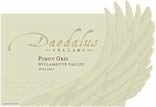 2007 Daedalus Cellars Willamette Valley Pinot Gris 13.6% alc., screw cap. Tall Alsatian bottle. From four vineyards (Carabella, Croft, Mahona and Murto) cropped to 2 tons per acre. Fermented with five different yeasts in 50% stainless steel and 50% neutral oak. · Rather intense aromas of pear, baking spices and almonds. Light and delicate flavors of pears and honey with a creamy mouth feel and some length to the finish.
 2007 King Estate Winery Oregon Signature Collection Pinot Gris 13.0% alc., 90,000 cases, $17. The winery also produces a higher end Pinot gris from 100% organically grown Estate fruit under the Domaine designation ($25). · Classic with white flower and honey aromas and flavors of pear, banana and melon. Appealing richness with a good grip on the finish.
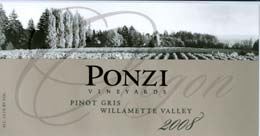 2007 Ponzi Vineyards Willamette Valley Pinot Gris 13.3% alc., 8,200 cases, $17, screw cap. · Faint yellow- color. Tropical fruits and grass with a hint of petrol. Demure fruit with racy acidity, a hint of spritz and a dry finish.
Serviceable:
 13.0% alc., 30,500 cases, $12, screw cap. · Very shy aromas of tropical fruit including guava. Light and delicate expanding somewhat with time in the glass but still is rather dilute.
The above wines represent only a small sampling of the large number of offerings of Pinot Gris from Oregon wineries. Practically every major producer of Pinot Noir in Oregon releases a Pinot Gris and they are usually available directly from the winery websites. Note: In 2009 I sampled two more Oregon Pinot Gris wines worthy of mention. Go to the winery's description and tasting notes for a review of these two wines: 2007 Lange Estate Winery & Vineyards Willamette Valley Pinot Gris and 2006 St. Innocent Vitae Springs Vineyard Willamette Valley Pinot Gris. The St. Innocent bottling is particularly stunning.
Pinot BriefsWine Judging is Inconsistent No surprise that a recent study published in the Journal of Wine Economics found that inconsistent judging makes wine awards less valuable as a consumer guide to wine quality. A survey of the judging panel of a prestigious annual wine competition found that less than half of the judges (30 out of 65) achieved anything close to consistent results. The results do not reflect badly on wine judges but indicate the difficulty faced in attempting to evaluate multiple wines at one sitting. Wineries love to use the results of wine competitions in their marketing programs, but they hold little significance for most wine connoisseurs who understand the vagaries of wine competitions. A Double Gold award or Best of Class award are probably the only wine competition rewards that merit serious attention. Oregon 2008 Report According to the recent issue of the Oregon Wine Press, vineyard acreage increased from 17,400 to 19,300 acres between 2007 and 2008 with Yamhill County boasting the largest amount of harvested acres (4,997). Pinot Noir is still the most harvested grape in tonnage, amounting to 17,571 tons in 2008, or 50.6% of total production in Oregon. At of the end of 2007, there were 9,858 acres planted to Pinot Noir in Oregon. The top five in order behind Pinot Noir included Pinot Gris, White Riesling, Chardonnay and Cabernet Sauvignon. The number of wineries increased from 370 to 395, still ranking Oregon third in the nation behind California and Washington State. The number of vinifera vineyards was 792. Wildfire Smoke Taints Some 2008 California Pinot Noirs Smoke from wildfires can infuse grapes with an aroma or flavor that is gamy or spicy. In small amounts, it is not particularly obnoxious, but in significant amounts can ruin the commercial acceptability of the wine. It is thought that the volatile compounds in smoke are either absorbed by the vines and transported to the grapes or adsorbed by the grapes directly. A number of filtering techniques have been tried to remove smoke taint but none will remove all the smoky aroma and flavor from significantly affected fruit. Of great concern is that even without wildfires in 2009, vines that yielded smoke tainted fruit in 2008 can do so again in 2009. Before this year’s recent World of Pinot Noir, winemakers gathered to taste smoke tainted Pinot Noirs and discuss ways of dealing with the problem. The press was not in attendance and the findings were not publicized, but I got the impression that smoke tainted wines still retained smoky aromas and flavors despite sophisticated filtering processes. There are no clear answers at present on how to remove the effects of smoke taint in wine. Ted Lemon of Littorai chose not to bottle several of his vineyard designates from the 2008 vintage. Some grapes from the Anderson Valley and Sonoma Coast did not even make it into the winery. All the Cerise, Savoy and Roman vineyards were declassified into the Les Larmes blend and all the Hirsch Vineyard fruit was declassified into the Sonoma Coast bottling. Some rosé was made as well. Ted decided to change his winemaking techniques to emphasize fruit and producer softer, earlier drinking wines from the affected grapes. He has offered the wines well before his usually release schedule and is selling them at reduced prices. He is to be commended for being outright honest about the situation and making the best wine he could out of a disturbing vintage. The vineyards which were unaffected by the wildfires in 2008 will be handled in the usual manner in the winery at Littorai. For more information, visit www.littorai.com.
 Santa Barbara County Vintner’s Festival This annual celebration will be held Saturday, April 18, 2009 at River Park in Lompoc. Over 100 Santa Barbara County wineries will be pouring along with gourmet wine country cuisine, a silent auction and live music. Tickets are $75 and can be obtained at www.sbccountywines.com. A four day (April 17-20) Vintner’s Visa to taste at 12 of your favorite wineries is available for $25 as well.
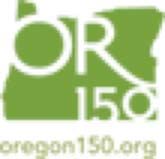 Oregon Celebrating 150 Years Participating Willamette Valley wineries are offering special wine tasting events and activities which began Valentine’s Day Weekend and extend through Labor Day Weekend. For example, April 18-19, 2009, the Dundee Hills Winegrowers Association will sponsor the 2009 Dundee Hills Passport Tour with participating wineries including Daedalus Cellars, Dobbes Family Estate, Domaine Serene, The Four Graces, Vista Hills Vineyard & Winery, Winderlea Vineyard & Winery and Winter’s Hill Vineyard. Visit www.willamettewines.com and www.oregon150.org for upcoming events. 2009 Guide to Willamette Valley Wineries This new guide contains a map and listings for 183 wineries and tasting rooms located throughout the Willamette Valley with the seven sub-AVAs highlighted in different colors. The guide also features dining, lodging and attractions in the Willamette Valley. The 19th annual Memorial Weekend in Wine Country is May 23-25, 2009 with more than 125 wineries and tasting rooms open to the public. A map and listing of participating wineries and their hours will be available online and by mail at the end of April. The new 2009 Guide to Willamette Valley Wineries and information on Wine Country Weekend are available at www.willamettewines.com. Food & Drink Pairing Widget Noted wine writer Natalie McClean has launched a new Drinks Matcher widget, a portable version of the site’s existing food and wine pairing feature. You can download the free Drinks Matcher widget to your computer desktop, website, blog or social media page like Facebook, MySpace or iGoogle from www.nataliemaclean.com/matcher. A mobile format is available for Blackberry, iPhones and SmartPhones. You can search for drinks to pair with food or vice versa. Vimentis Brings Ritual and Romance to the Screw Cap The Vimentis was developed to replicate the cork’s trademark ritual for screw cap wine opening. The one-time use Vimentis device is made up of a clear cylinder attached to a flat tab that is pushed down and locked on to the unopened wine cap. The whole Vimentis is turned to unscrew the cap, mimicking the rotation of the traditional corkscrew. The clear Vimentis, with the screw cap embedded within, can them be retained, much as a traditional cork. The Vimentis tab can be custom branded for marketing purposes.
 2008 Wine Market Council Consumer Tracking Study Overall table wine consumption increased for the 15th straight year in 2008. Generation X (ages 32 to 43 in 2008) and the Millennial population (15 to 31 in 2008) have been taking to wine in significant numbers at the expense of beer and spirits. Core wine drinkers (those that drink wine at least once a week) have increased 60% since 2000 and red wines account for more than 50% of their wine purchases. Domestic wines are favored over imports 2 to 1. California wines ranked high in flavor, value and overall enjoyment while Oregon wines were rated as the most unique. Balancing Act Over 15% Alcohol At the recent World of Pinot Noir, the roving Grape Radio crew asked several winemakers on camera if they thought that New World Pinot Noir could be produced with 15% or more alcohol and still be in balance. The answers covered the broad range from “no” to “possibly” to “yes.” The term balance refers to the harmonious or seamless combination of all components of wine including fruit, tannin, acid and alcohol so that no one component sticks out. The presence or absence of balance is a key criteria wine critics and judges use to judge the quality of a wine and predict its age ability. If a wine is not balanced at the onset, it will never become balanced, regardless of how long it is cellared. Wines that are seemingly balanced at the start, however, can lose that balance over time. Since the percentage of alcohol in a wine never changes over time, the gradual loss of tannins and fruit with aging can bring alcohol to the forefront and create an unbalance. This is often given as a criticism of high alcohol wines. Look for the winemaker comments in an upcoming video at www.graperadio.com. Don’t Forget the 2006 and 2007 Vintages in Burgundy The French feel we Americans fret too much over vintages. They are more inclined to revile in vintage differences and accept it as part of the charm of wine. The 2005 vintage for red Burgundy was a blockbuster and the two vintages that followed are surely to receive less attention by American Burgundy lovers. The truth is that both the 2006 and 2007 vintages were saved by good weather at the end of the growing season and are appealing vintages with good transparency, expression of terroir and upfront drinkability. According to Anthony Rose and Margaret Rand, writing in The World of Fine Wine (Issue 23, 2009), “ The 2007 wines are on the light side. They are not excessively tannic, nor are acidities especially high, but there are some signs of greenness, though it is not a dominant feature of the vintage. It seems that the Cote de Beaune fared slightly less well than the Cote de Nuits. I am not convinced that the reds are, as some claim, better than 2006, a vintage that I believe has been underestimated for reds.” International Wine Review Report on Oregon Pinot Noir International Wine Review does in-depth reports on important wine regions of the world accompanied by tasting notes and ratings of new wines on the market. The latest Oregon Pinot Noir Report is now available. This 52-page comprehensive report examines the factors that have contributed to the success of Oregon Pinot Noir including the soils, climate and viticultural practices. Sustainable, organic and biodynamic viticulture practices are discussed along with minimalist winemaking practices currently prevalent in Oregon. The report includes reviews of more than 200 Oregon Pinot Noirs from distinguished producers and a list of top rated Oregon Pinot Noirs under $35. I have never seen such extensive coverage of the Oregon PInot Noir scene. Subscriptions to the International Wine Review are $50 for the online edition. (The Oregon Pinot Noir Report is worth $50 alone!). Visit the website at www.i-winereview.com.
Vignette Wine Country SodaVignette Wine Country Soda is an all-natural, non alcoholic, lightly carbonated soda sweetened with fresh wine grape concentrate. Vignette is the creation of San Francisco Bay Area entrepreneur Pat Galvin. Galvin’s curiosity for good food and wine began when he spent a semester in Provence while studying for his B.A. in European Studies and French at Vanderbilt University. He subsequently settled in Berkeley and his proximity to the wine country of Northern California combined with a growing interest in gourmet soft drinks served as his inspiration for Vignette Wine Country Soda. He noted that no one was using high quality wine grapes for any type of soft drink. Although Galvin officially launched Vignette Wine Country Soda with the crush season of 2006, carting bottles of the effervescent wine-based soda to local stores, cafes and events, it was not until 2007 that Vignette started appearing in speciality markets and restaurants throughout Napa Valley and San Francisco. The sodas are ideal for a picnic, abstainers, designated drivers, pregnant women, underage young people who are curious about wine and people that enjoy wine but cannot partake for health reasons. There is no highfructose corn syrup, caffeine or preservatives found in commercial soft drinks and soda. The sodas are presented in 12-ounce glass bottles (about a half-bottle of wine in size) with re-sealable metal twist off caps. A pleasing little pop accompanies the opening of a bottle. Each bottle is composed of 50% juice and contains 100 to 110 calories with 25 to 28 grams of sugar. I found the sodas very refreshing when properly served chilled with flavors resembling those of wine. Currently available flavors include Rosé, Chardonnay and Pinot Noir. Vignette Wine Country Soda is available at select restaurants and gourmet food stores such as Bristol Farms or can be ordered online at www.hellodelicious.com and www.winecountrysoda.com. The sodas can also be used as a mixer for cocktails such as the Pinot-rita which is composed of 1 part Vignette Wine Country Pinot Noir soda, 2 parts margarita mix, 1 part tequila combined with ice in a cocktail shaker and poured into a salt-rimmed martini glass. A very tasty margarita with a wine country taste. Unlike Pinot Noir, it is a perfect accompaniment to chips and salsa. Vignette Wine Country Rosé Soda From Grenache, Pinot Noir and Sauvignon Blanc grape juice concentrates. Lovely pink-salmon color. Fruity aromas with bright and mildly sweet berry flavors. Delicious and my favorite. Vignette Wine Country Chardonnay Soda From Chardonnay grape juice concentrate. Very pale yellow-gold color. Aromas of fermenting grapes and yeast. Pleasant demure flavors of slightlyoverripe grapes, pear and yellow raisins. Reminded me of Chenin Blanc in taste. Vignette Wine Country Pinot Noir Soda From Pinot Noir grape juice concentrate. Moderately deep garnet color. Bright raspberry aromas. Tasty black cherry and black raspberry flavors similar to an intense black cherry soda.
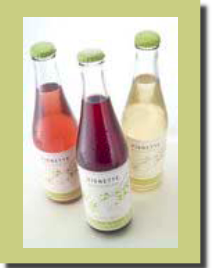 |